Liberty Place monument in New Orleans becomes 1st of 4 to be taken down
- BY JEFF ADELSON | jadelson@theadvocate.com, JEFF NOWAK | jnowak@theadvocate.com
- (42)
- Advocate staff photo by MATTHEW HINTON
A portion of a white supremacist monument is removed by the One Canal Place parking lot and Mississippi
River floodwall at the end of Iberville Street in New Orleans, La. Monday, April 24, 2017. The monument
was erected by the Crescent City White League, including Confederate veterans, who attempted an
overthrow of the Reconstruction Louisiana government made up of the outnumbered Metropolitan Police
and state militia. It commemorates the attack on an integrated police force where nine officers were said to
have been killed on September 14, 1874 by white supremacists. The White League called the insurrection '
The Battle of Liberty Place.' The original inscription hailed the success of white supremacy in the 'overthrow
of carpetbag government.' Order was restored when the federal troops in came to the city January 1875.
When the obelisk was moved in 1993, the inscription was changed to 'honor Americans on both sides who
died.' The inscription has been smashed recently and faint graffiti remnants can be seen above the inscription.
River floodwall at the end of Iberville Street in New Orleans, La. Monday, April 24, 2017. The monument
was erected by the Crescent City White League, including Confederate veterans, who attempted an
overthrow of the Reconstruction Louisiana government made up of the outnumbered Metropolitan Police
and state militia. It commemorates the attack on an integrated police force where nine officers were said to
have been killed on September 14, 1874 by white supremacists. The White League called the insurrection '
The Battle of Liberty Place.' The original inscription hailed the success of white supremacy in the 'overthrow
of carpetbag government.' Order was restored when the federal troops in came to the city January 1875.
When the obelisk was moved in 1993, the inscription was changed to 'honor Americans on both sides who
died.' The inscription has been smashed recently and faint graffiti remnants can be seen above the inscription.
- Advocate staff photo by SCOTT THRELKELD
The Liberty Place monument near One Canal Place is dismantled Monday, April 24, 2017, and hauled away. The statue and three other white supremacist and Confederate statues are to be removed after the city council voted 6-1 to have the statues removed from public display in Dec. 2015. The monument was erected by the Crescent City White League, including Confederate veterans, who attempted an overthrow of the Reconstruction Louisiana government made up of the outnumbered Metropolitan Police and state militia. It commemorates the attack on an integrated police force where nine officers were said to have been killed on September 14, 1874 by white supremacists. The White League called the insurrection 'The Battle of Liberty Place.' The original inscription hailed the success of white supremacy in the 'overthrow of carpetbag government.' Order was restored when the federal troops in came to the city January 1875. When the obelisk was moved in 1993, the inscription was changed to 'honor Americans on both sides who died.' The inscription has been smashed recently.
- Advocate staff photo by JEFF NOWAK
A woman protesting against the takedown of New Orleans' Confederate monuments stands in front of a counterprotestor holding a Black Lives Matter sign at the statue of Confederate president Jefferson Davis early Monday morning in Mid-City.
- Advocate staff photo by SCOTT THRELKELD
The Liberty Place monument near One Canal Place is dismantled Monday, April 24, 2017, and hauled away. The statue and three other white supremacist and Confederate statues are to be removed after the city council voted 6-1 to have the statues removed from public display in Dec. 2015. The monument was erected by the Crescent City White League, including Confederate veterans, who attempted an overthrow of the Reconstruction Louisiana government made up of the outnumbered Metropolitan Police and state militia. It commemorates the attack on an integrated police force where nine officers were said to have been killed on September 14, 1874 by white supremacists. The White League called the insurrection 'The Battle of Liberty Place.' The original inscription hailed the success of white supremacy in the 'overthrow of carpetbag government.' Order was restored when the federal troops in came to the city January 1875. When the obelisk was moved in 1993, the inscription was changed to 'honor Americans on both sides who died.' The inscription has been smashed recently.
- Advocate staff photo by SCOTT THRELKELD
New Orleans police stand guard as the Liberty Place monument near One Canal Place is dismantled Monday, April 24, 2017, and hauled away. The statue and three other white supremacist and Confederate statues are to be removed after the city council voted 6-1 to have the statues removed from public display in Dec. 2015. The monument was erected by the Crescent City White League, including Confederate veterans, who attempted an overthrow of the Reconstruction Louisiana government made up of the outnumbered Metropolitan Police and state militia. It commemorates the attack on an integrated police force where nine officers were said to have been killed on September 14, 1874 by white supremacists. The White League called the insurrection 'The Battle of Liberty Place.' The original inscription hailed the success of white supremacy in the 'overthrow of carpetbag government.' Order was restored when the federal troops in came to the city January 1875. When the obelisk was moved in 1993, the inscription was changed to 'honor Americans on both sides who died.' The inscription has been smashed recently.
- Advocate staff photo by SCOTT THRELKELD
Nathan Laurenson of New Orleans, left, argues with an unidentified woman, right, about the removal of the Liberty Place monument near One Canal Place Monday, April 24, 2017. The statue and three other white supremacist and Confederate statues are to be removed after the city council voted 6-1 to have the statues removed from public display in Dec. 2015. The monument was erected by the Crescent City White League, including Confederate veterans, who attempted an overthrow of the Reconstruction Louisiana government made up of the outnumbered Metropolitan Police and state militia. It commemorates the attack on an integrated police force where nine officers were said to have been killed on September 14, 1874 by white supremacists. The White League called the insurrection 'The Battle of Liberty Place.' The original inscription hailed the success of white supremacy in the 'overthrow of carpetbag government.' Order was restored when the federal troops in came to the city January 1875. When the obelisk was moved in 1993, the inscription was changed to 'honor Americans on both sides who died.' The inscription has been smashed recently.
- Advocate staff photo by SCOTT THRELKELD
The Liberty Place monument near One Canal Place is dismantled Monday, April 24, 2017, and hauled away. The statue and three other white supremacist and Confederate statues are to be removed after the city council voted 6-1 to have the statues removed from public display in Dec. 2015. The monument was erected by the Crescent City White League, including Confederate veterans, who attempted an overthrow of the Reconstruction Louisiana government made up of the outnumbered Metropolitan Police and state militia. It commemorates the attack on an integrated police force where nine officers were said to have been killed on September 14, 1874 by white supremacists. The White League called the insurrection 'The Battle of Liberty Place.' The original inscription hailed the success of white supremacy in the 'overthrow of carpetbag government.' Order was restored when the federal troops in came to the city January 1875. When the obelisk was moved in 1993, the inscription was changed to 'honor Americans on both sides who died.' The inscription has been smashed recently.
- Advocate staff photo by JEFF NOWAK
Pierre McGraw of Monumental Task Force speaking speaking in front of Jefferson Davis monument in New Orleans.
- Advocate staff photo by JEFF NOWAK
A counter-protester, Chris Daemmrich, arrived at the Jefferson Davis vigil. He said he's from Austin, Texas, and was accused of being a paid protester.
- Advocate staff photo by JEFF NOWAK
A man protesting against the takedown of New Orleans' Confederate monuments holds a sign reading "Witness the decline of western civilization" at the statue of Confederate president Jefferson Davis early Monday morning in Mid-City during a candlelight vigil. The Monumental Task Committee organized the vigil.
- Advocate staff photo by JEFF NOWAK
A woman protesting against the take down of New Orleans' Confederate monuments holds a sign reading "My city, my history, my monuments" in front of the statue of Confederate president Jefferson Davis early Monday morning in Mid-City.
- Advocate staff photo by JEFF NOWAK
Protesters against the take down of New Orleans' Confederate monuments gather for a candlelight vigil at the statue of Confederate president Jefferson Davis early Monday morning in Mid-City. The vigil was organized by the Monumental Task Committee.
- Advocate staff photo by JEFF NOWAK
Protesters placed candles on and around the statue of Confederate president Jefferson Davis early Monday morning in Mid-City during a candlelight vigil organized by the Monumental Task Committee in response to the beginning of the city's take down of several Confederate monuments.
- Advocate staff photo by SCOTT THRELKELD
The Liberty Place monument near One Canal Place is dismantled Monday, April 24, 2017, and hauled away. The statue and three other white supremacist and Confederate statues are to be removed after the city council voted 6-1 to have the statues removed from public display in Dec. 2015. The monument was erected by the Crescent City White League, including Confederate veterans, who attempted an overthrow of the Reconstruction Louisiana government made up of the outnumbered Metropolitan Police and state militia. It commemorates the attack on an integrated police force where nine officers were said to have been killed on September 14, 1874 by white supremacists. The White League called the insurrection 'The Battle of Liberty Place.' The original inscription hailed the success of white supremacy in the 'overthrow of carpetbag government.' Order was restored when the federal troops in came to the city January 1875. When the obelisk was moved in 1993, the inscription was changed to 'honor Americans on both sides who died.' The inscription has been smashed recently.
- Advocate staff photo by SCOTT THRELKELD
The Liberty Place monument near One Canal Place is dismantled Monday, April 24, 2017, and hauled away. The statue and three other white supremacist and Confederate statues are to be removed after the city council voted 6-1 to have the statues removed from public display in Dec. 2015. The monument was erected by the Crescent City White League, including Confederate veterans, who attempted an overthrow of the Reconstruction Louisiana government made up of the outnumbered Metropolitan Police and state militia. It commemorates the attack on an integrated police force where nine officers were said to have been killed on September 14, 1874 by white supremacists. The White League called the insurrection 'The Battle of Liberty Place.' The original inscription hailed the success of white supremacy in the 'overthrow of carpetbag government.' Order was restored when the federal troops in came to the city January 1875. When the obelisk was moved in 1993, the inscription was changed to 'honor Americans on both sides who died.' The inscription has been smashed recently.
- Advocate staff photo by SCOTT THRELKELD
The Liberty Place monument near One Canal Place is dismantled Monday, April 24, 2017, and hauled away. The statue and three other white supremacist and Confederate statues are to be removed after the city council voted 6-1 to have the statues removed from public display in Dec. 2015. The monument was erected by the Crescent City White League, including Confederate veterans, who attempted an overthrow of the Reconstruction Louisiana government made up of the outnumbered Metropolitan Police and state militia. It commemorates the attack on an integrated police force where nine officers were said to have been killed on September 14, 1874 by white supremacists. The White League called the insurrection 'The Battle of Liberty Place.' The original inscription hailed the success of white supremacy in the 'overthrow of carpetbag government.' Order was restored when the federal troops in came to the city January 1875. When the obelisk was moved in 1993, the inscription was changed to 'honor Americans on both sides who died.' The inscription has been smashed recently.
- Advocate staff photo by SCOTT THRELKELD
The Liberty Place monument near One Canal Place is dismantled Monday, April 24, 2017, and hauled away. The statue and three other white supremacist and Confederate statues are to be removed after the city council voted 6-1 to have the statues removed from public display in Dec. 2015. The monument was erected by the Crescent City White League, including Confederate veterans, who attempted an overthrow of the Reconstruction Louisiana government made up of the outnumbered Metropolitan Police and state militia. It commemorates the attack on an integrated police force where nine officers were said to have been killed on September 14, 1874 by white supremacists. The White League called the insurrection 'The Battle of Liberty Place.' The original inscription hailed the success of white supremacy in the 'overthrow of carpetbag government.' Order was restored when the federal troops in came to the city January 1875. When the obelisk was moved in 1993, the inscription was changed to 'honor Americans on both sides who died.' The inscription has been smashed recently.
- Advocate staff photo by SCOTT THRELKELD
The Liberty Place monument near One Canal Place is dismantled Monday, April 24, 2017, and hauled away. The statue and three other white supremacist and Confederate statues are to be removed after the city council voted 6-1 to have the statues removed from public display in Dec. 2015. The monument was erected by the Crescent City White League, including Confederate veterans, who attempted an overthrow of the Reconstruction Louisiana government made up of the outnumbered Metropolitan Police and state militia. It commemorates the attack on an integrated police force where nine officers were said to have been killed on September 14, 1874 by white supremacists. The White League called the insurrection 'The Battle of Liberty Place.' The original inscription hailed the success of white supremacy in the 'overthrow of carpetbag government.' Order was restored when the federal troops in came to the city January 1875. When the obelisk was moved in 1993, the inscription was changed to 'honor Americans on both sides who died.' The inscription has been smashed recently.
- Advocate staff photo by SCOTT THRELKELD
The Liberty Place monument near One Canal Place is dismantled Monday, April 24, 2017, and hauled away. The statue and three other white supremacist and Confederate statues are to be removed after the city council voted 6-1 to have the statues removed from public display in Dec. 2015. The monument was erected by the Crescent City White League, including Confederate veterans, who attempted an overthrow of the Reconstruction Louisiana government made up of the outnumbered Metropolitan Police and state militia. It commemorates the attack on an integrated police force where nine officers were said to have been killed on September 14, 1874 by white supremacists. The White League called the insurrection 'The Battle of Liberty Place.' The original inscription hailed the success of white supremacy in the 'overthrow of carpetbag government.' Order was restored when the federal troops in came to the city January 1875. When the obelisk was moved in 1993, the inscription was changed to 'honor Americans on both sides who died.' The inscription has been smashed recently.
- Advocate staff photo by SCOTT THRELKELD
A man waves an anti-fascist flag as the Liberty Place monument near One Canal Place is dismantled Monday, April 24, 2017, and hauled away. The statue and three other white supremacist and Confederate statues are to be removed after the city council voted 6-1 to have the statues removed from public display in Dec. 2015. The monument was erected by the Crescent City White League, including Confederate veterans, who attempted an overthrow of the Reconstruction Louisiana government made up of the outnumbered Metropolitan Police and state militia. It commemorates the attack on an integrated police force where nine officers were said to have been killed on September 14, 1874 by white supremacists. The White League called the insurrection 'The Battle of Liberty Place.' The original inscription hailed the success of white supremacy in the 'overthrow of carpetbag government.' Order was restored when the federal troops in came to the city January 1875. When the obelisk was moved in 1993, the inscription was changed to 'honor Americans on both sides who died.' The inscription has been smashed recently.
- Advocate staff photo by SCOTT THRELKELD
Supporters for keeping New Orleans historical monuments in place gather for a candlelight vigil late Sunday, April 23, 2017, at Liberty Place monument near One Canal Place.
- Advocate staff photo by SCOTT THRELKELD
Supporters for keeping New Orleans historical monuments in place gather for a candlelight vigil late Sunday, April 23, 2017, at Liberty Place monument near One Canal Place.
- Advocate staff photo by SCOTT THRELKELD
Kasey Cole, right, her husband, Steve Cole, second from right, and other supporters gather for a candlelight vigil late Sunday, April 23, 2017, at Liberty Place monument near One Canal Place.
- Advocate staff photo by SCOTT THRELKELD
New Orleans police move barricades at Liberty Place monument near One Canal Place before the statue is dismantled Monday, April 24, 2017, and hauled away. The statue and three other white supremacist and Confederate statues are to be removed after the city council voted 6-1 to have the statues removed from public display in Dec. 2015. The monument was erected by the Crescent City White League, including Confederate veterans, who attempted an overthrow of the Reconstruction Louisiana government made up of the outnumbered Metropolitan Police and state militia. It commemorates the attack on an integrated police force where nine officers were said to have been killed on September 14, 1874 by white supremacists. The White League called the insurrection 'The Battle of Liberty Place.' The original inscription hailed the success of white supremacy in the 'overthrow of carpetbag government.' Order was restored when the federal troops in came to the city January 1875. When the obelisk was moved in 1993, the inscription was changed to 'honor Americans on both sides who died.' The inscription has been smashed recently.
- Advocate staff photo by SCOTT THRELKELD
Supporters for keeping New Orleans historical monuments in place gather for a candlelight vigil late Sunday, April 23, 2017, at Liberty Place monument near One Canal Place.
- Advocate staff photo by SCOTT THRELKELD
Joey Cargol of New Orleans voices his disapproval as the Liberty Place monument near One Canal Place is dismantled Monday, April 24, 2017, and hauled away. The statue and three other white supremacist and Confederate statues are to be removed after the city council voted 6-1 to have the statues removed from public display in Dec. 2015. The monument was erected by the Crescent City White League, including Confederate veterans, who attempted an overthrow of the Reconstruction Louisiana government made up of the outnumbered Metropolitan Police and state militia. It commemorates the attack on an integrated police force where nine officers were said to have been killed on September 14, 1874 by white supremacists. The White League called the insurrection 'The Battle of Liberty Place.' The original inscription hailed the success of white supremacy in the 'overthrow of carpetbag government.' Order was restored when the federal troops in came to the city January 1875. When the obelisk was moved in 1993, the inscription was changed to 'honor Americans on both sides who died.' The inscription has been smashed recently.
- Advocate staff photo by SCOTT THRELKELD
Workers wear bullet-proof vests and face masks as Liberty Place monument near One Canal Place is dismantled Monday, April 24, 2017, and hauled away. The statue and three other white supremacist and Confederate statues are to be removed after the city council voted 6-1 to have the statues removed from public display in Dec. 2015. The monument was erected by the Crescent City White League, including Confederate veterans, who attempted an overthrow of the Reconstruction Louisiana government made up of the outnumbered Metropolitan Police and state militia. It commemorates the attack on an integrated police force where nine officers were said to have been killed on September 14, 1874 by white supremacists. The White League called the insurrection 'The Battle of Liberty Place.' The original inscription hailed the success of white supremacy in the 'overthrow of carpetbag government.' Order was restored when the federal troops in came to the city January 1875. When the obelisk was moved in 1993, the inscription was changed to 'honor Americans on both sides who died.' The inscription has been smashed recently.
- Advocate staff photo by SCOTT THRELKELD
Steve Cole, left, and supporters for keeping New Orleans historical monuments in place gather for a candlelight vigil late Sunday, April 23, 2017, at Liberty Place monument near One Canal Place.
- Advocate staff photo by SCOTT THRELKELD
A truck involved with the dismantling of the Liberty Place monument has its company name and license plate covered with cardboard Monday, April 24, 2017, near One Canal Place. The statue and three other white supremacist and Confederate statues are to be removed after the city council voted 6-1 to have the statues removed from public display in Dec. 2015. The monument was erected by the Crescent City White League, including Confederate veterans, who attempted an overthrow of the Reconstruction Louisiana government made up of the outnumbered Metropolitan Police and state militia. It commemorates the attack on an integrated police force where nine officers were said to have been killed on September 14, 1874 by white supremacists. The White League called the insurrection 'The Battle of Liberty Place.' The original inscription hailed the success of white supremacy in the 'overthrow of carpetbag government.' Order was restored when the federal troops in came to the city January 1875. When the obelisk was moved in 1993, the inscription was changed to 'honor Americans on both sides who died.' The inscription has been smashed recently.
- Advocate staff photo by MATTHEW HINTON
A portion of a white supremacist monument is removed by the One Canal Place parking lot and Mississippi River floodwall at the end of Iberville Street in New Orleans, La. Monday, April 24, 2017. The monument was erected by the Crescent City White League, including Confederate veterans, who attempted an overthrow of the Reconstruction Louisiana government made up of the outnumbered Metropolitan Police and state militia. It commemorates the attack on an integrated police force where nine officers were said to have been killed on September 14, 1874 by white supremacists. The White League called the insurrection 'The Battle of Liberty Place.' The original inscription hailed the success of white supremacy in the 'overthrow of carpetbag government.' Order was restored when the federal troops in came to the city January 1875. When the obelisk was moved in 1993, the inscription was changed to 'honor Americans on both sides who died.' The inscription has been smashed recently and faint graffiti remnants can be seen above the inscription.
- Advocate staff photo by MATTHEW HINTON
A portion of a white supremacist monument is removed by the One Canal Place parking lot and Mississippi River floodwall at the end of Iberville Street in New Orleans, La. Monday, April 24, 2017. The monument was erected by the Crescent City White League, including Confederate veterans, who attempted an overthrow of the Reconstruction Louisiana government made up of the outnumbered Metropolitan Police and state militia. It commemorates the attack on an integrated police force where nine officers were said to have been killed on September 14, 1874 by white supremacists. The White League called the insurrection 'The Battle of Liberty Place.' The original inscription hailed the success of white supremacy in the 'overthrow of carpetbag government.' Order was restored when the federal troops in came to the city January 1875. When the obelisk was moved in 1993, the inscription was changed to 'honor Americans on both sides who died.' The inscription has been smashed recently and faint graffiti remnants can be seen above the inscription.
- Advocate staff photo by MATTHEW HINTON
A portion of a white supremacist monument is removed by the One Canal Place parking lot and Mississippi River floodwall at the end of Iberville Street in New Orleans, La. Monday, April 24, 2017. The monument was erected by the Crescent City White League, including Confederate veterans, who attempted an overthrow of the Reconstruction Louisiana government made up of the outnumbered Metropolitan Police and state militia. It commemorates the attack on an integrated police force where nine officers were said to have been killed on September 14, 1874 by white supremacists. The White League called the insurrection 'The Battle of Liberty Place.' The original inscription hailed the success of white supremacy in the 'overthrow of carpetbag government.' Order was restored when the federal troops in came to the city January 1875. When the obelisk was moved in 1993, the inscription was changed to 'honor Americans on both sides who died.' The inscription has been smashed recently and faint graffiti remnants can be seen above the inscription.
- Advocate staff photo by MATTHEW HINTON
A portion of a white supremacist monument is removed by the One Canal Place parking lot and Mississippi River floodwall at the end of Iberville Street in New Orleans, La. Monday, April 24, 2017. The monument was erected by the Crescent City White League, including Confederate veterans, who attempted an overthrow of the Reconstruction Louisiana government made up of the outnumbered Metropolitan Police and state militia. It commemorates the attack on an integrated police force where nine officers were said to have been killed on September 14, 1874 by white supremacists. The White League called the insurrection 'The Battle of Liberty Place.' The original inscription hailed the success of white supremacy in the 'overthrow of carpetbag government.' Order was restored when the federal troops in came to the city January 1875. When the obelisk was moved in 1993, the inscription was changed to 'honor Americans on both sides who died.' The inscription has been smashed recently and faint graffiti remnants can be seen above the inscription.
- Advocate staff photo by MATTHEW HINTON
A portion of a white supremacist monument is removed by the One Canal Place parking lot and Mississippi River floodwall at the end of Iberville Street in New Orleans, La. Monday, April 24, 2017. The monument was erected by the Crescent City White League, including Confederate veterans, who attempted an overthrow of the Reconstruction Louisiana government made up of the outnumbered Metropolitan Police and state militia. It commemorates the attack on an integrated police force where nine officers were said to have been killed on September 14, 1874 by white supremacists. The White League called the insurrection 'The Battle of Liberty Place.' The original inscription hailed the success of white supremacy in the 'overthrow of carpetbag government.' Order was restored when the federal troops in came to the city January 1875. When the obelisk was moved in 1993, the inscription was changed to 'honor Americans on both sides who died.' The inscription has been smashed recently and faint graffiti remnants can be seen above the inscription.
- Advocate staff photo by MATTHEW HINTON
A portion of a white supremacist monument is removed by the One Canal Place parking lot and Mississippi River floodwall at the end of Iberville Street in New Orleans, La. Monday, April 24, 2017. The monument was erected by the Crescent City White League, including Confederate veterans, who attempted an overthrow of the Reconstruction Louisiana government made up of the outnumbered Metropolitan Police and state militia. It commemorates the attack on an integrated police force where nine officers were said to have been killed on September 14, 1874 by white supremacists. The White League called the insurrection 'The Battle of Liberty Place.' The original inscription hailed the success of white supremacy in the 'overthrow of carpetbag government.' Order was restored when the federal troops in came to the city January 1875. When the obelisk was moved in 1993, the inscription was changed to 'honor Americans on both sides who died.' The inscription has been smashed recently and faint graffiti remnants can be seen above the inscription.
- Advocate staff photo by MATTHEW HINTON
Members of the Monumental Task Committee hold a vigil at the 1911 Jefferson Davis Monument on Jefferson Davis Parkway in New Orleans, La. after midnight Sunday into Monday, April 24, 2017 as rumors swirl of the monument's imminent removal. The statue and three other white supremacist and Confederate statues are to be removed after the city council voted 6-1 to have the statues removed from public display in Dec. 2015. Davis was the president of the Confederacy in the Civil War. The street the statue sits on was originally named Hagan Avenue, but the name was changed in 1911 with the statue's placement.
- Advocate staff photo by MATTHEW HINTON
A portion of a white supremacist monument is removed by the One Canal Place parking lot and Mississippi River floodwall at the end of Iberville Street in New Orleans, La. Monday, April 24, 2017. The monument was erected by the Crescent City White League, including Confederate veterans, who attempted an overthrow of the Reconstruction Louisiana government made up of the outnumbered Metropolitan Police and state militia. It commemorates the attack on an integrated police force where nine officers were said to have been killed on September 14, 1874 by white supremacists. The White League called the insurrection 'The Battle of Liberty Place.' The original inscription hailed the success of white supremacy in the 'overthrow of carpetbag government.' Order was restored when the federal troops in came to the city January 1875. When the obelisk was moved in 1993, the inscription was changed to 'honor Americans on both sides who died.' The inscription has been smashed recently and faint graffiti remnants can be seen above the inscription.
- Advocate staff photo by MATTHEW HINTON
Members of the Monumental Task Committee hold a vigil at the 1911 Jefferson Davis Monument on Jefferson Davis Parkway in New Orleans, La. after midnight Sunday into Monday, April 24, 2017 as rumors swirl of the monument's imminent removal. The statue and three other white supremacist and Confederate statues are to be removed after the city council voted 6-1 to have the statues removed from public display in Dec. 2015. Davis was the president of the Confederacy in the Civil War. The street the statue sits on was originally named Hagan Avenue, but the name was changed in 1911 with the statue's placement.
- Advocate staff photo by MATTHEW HINTON
A portion of a white supremacist monument is removed by the One Canal Place parking lot and Mississippi River floodwall at the end of Iberville Street in New Orleans, La. Monday, April 24, 2017. The monument was erected by the Crescent City White League, including Confederate veterans, who attempted an overthrow of the Reconstruction Louisiana government made up of the outnumbered Metropolitan Police and state militia. It commemorates the attack on an integrated police force where nine officers were said to have been killed on September 14, 1874 by white supremacists. The White League called the insurrection 'The Battle of Liberty Place.' The original inscription hailed the success of white supremacy in the 'overthrow of carpetbag government.' Order was restored when the federal troops in came to the city January 1875. When the obelisk was moved in 1993, the inscription was changed to 'honor Americans on both sides who died.' The inscription has been smashed recently and faint graffiti remnants can be seen above the inscription.
- Advocate staff photo by MATTHEW HINTON
Members of the Monumental Task Committee hold a vigil at the 1911 Jefferson Davis Monument on Jefferson Davis Parkway in New Orleans, La. after midnight Sunday into Monday, April 24, 2017 as rumors swirl of the monument's imminent removal. The statue and three other white supremacist and Confederate statues are to be removed after the city council voted 6-1 to have the statues removed from public display in Dec. 2015. Davis was the president of the Confederacy in the Civil War. The street the statue sits on was originally named Hagan Avenue, but the name was changed in 1911 with the statue's placement.
- Advocate staff photo by MATTHEW HINTON
Members of the Monumental Task Committee including Michael Rouchell hold a vigil at the 1911 Jefferson Davis Monument on Jefferson Davis Parkway in New Orleans, La. after midnight Sunday into Monday, April 24, 2017 as rumors swirl of the monument's imminent removal. The statue and three other white supremacist and Confederate statues are to be removed after the city council voted 6-1 to have the statues removed from public display in Dec. 2015. Davis was the president of the Confederacy in the Civil War. The street the statue sits on was originally named Hagan Avenue, but the name was changed in 1911 with the statue's placement.
- Advocate staff photo by MATTHEW HINTON
Members of the Monumental Task Committee hold a vigil at the 1911 Jefferson Davis Monument on Jefferson Davis Parkway in New Orleans, La. after midnight Sunday into Monday, April 24, 2017 as rumors swirl of the monument's imminent removal. The statue and three other white supremacist and Confederate statues are to be removed after the city council voted 6-1 to have the statues removed from public display in Dec. 2015. Davis was the president of the Confederacy in the Civil War. The street the statue sits on was originally named Hagan Avenue, but the name was changed in 1911 with the statue's placement.
- Advocate staff photo by MATTHEW HINTON
Members of the Monumental Task Committee including Charles Edward Lincoln hold a vigil at the 1911 Jefferson Davis Monument on Jefferson Davis Parkway in New Orleans, La. after midnight Sunday into Monday, April 24, 2017 as rumors swirl of the monument's imminent removal. The statue and three other white supremacist and Confederate statues are to be removed after the city council voted 6-1 to have the statues removed from public display in Dec. 2015. Davis was the president of the Confederacy in the Civil War. The street the statue sits on was originally named Hagan Avenue, but the name was changed in 1911 with the statue's placement.
- Advocate staff photo by MATTHEW HINTON
Members of the Monumental Task Committee including Pat Gallagher, left, and Marlane Drake, holding candle right, talk to Mike Bowser, who lives nearby and doesn't understand the media as they hold a vigil at the 1911 Jefferson Davis Monument on Jefferson Davis Parkway in New Orleans, La. after midnight Sunday into Monday, April 24, 2017 as rumors swirl of the monument's imminent removal. Lincoln invited people to sign a petition to have the statues be declared a world heritage site. The statue and three other white supremacist and Confederate statues are to be removed after the city council voted 6-1 to have the statues removed from public display in Dec. 2015. Davis was the president of the Confederacy in the Civil War. The street the statue sits on was originally named Hagan Avenue, but the name was changed in 1911 with the statue's placement.
- Advocate staff photo by MATTHEW HINTON
A portion of a white supremacist monument is removed by the One Canal Place parking lot and Mississippi River floodwall at the end of Iberville Street in New Orleans, La. Monday, April 24, 2017. The monument was erected by the Crescent City White League, including Confederate veterans, who attempted an overthrow of the Reconstruction Louisiana government made up of the outnumbered Metropolitan Police and state militia. It commemorates the attack on an integrated police force where nine officers were said to have been killed on September 14, 1874 by white supremacists. The White League called the insurrection 'The Battle of Liberty Place.' The original inscription hailed the success of white supremacy in the 'overthrow of carpetbag government.' Order was restored when the federal troops in came to the city January 1875. When the obelisk was moved in 1993, the inscription was changed to 'honor Americans on both sides who died.' The inscription has been smashed recently and faint graffiti remnants can be seen above the inscription.
- Advocate staff photo by MATTHEW HINTON
Members of the Monumental Task Committee including Charles Edward Lincoln hold a vigil at the 1911 Jefferson Davis Monument on Jefferson Davis Parkway in New Orleans, La. after midnight Sunday into Monday, April 24, 2017 as rumors swirl of the monument's imminent removal. Lincoln invited people to sign a petition to have the statues be declared a world heritage site. The statue and three other white supremacist and Confederate statues are to be removed after the city council voted 6-1 to have the statues removed from public display in Dec. 2015. Davis was the president of the Confederacy in the Civil War. The street the statue sits on was originally named Hagan Avenue, but the name was changed in 1911 with the statue's placement.
- Advocate staff photo by MATTHEW HINTON
Members of the Monumental Task Committee hold a vigil at the 1911 Jefferson Davis Monument on Jefferson Davis Parkway in New Orleans, La. after midnight Sunday into Monday, April 24, 2017 as rumors swirl of the monument's imminent removal. The statue and three other white supremacist and Confederate statues are to be removed after the city council voted 6-1 to have the statues removed from public display in Dec. 2015. Davis was the president of the Confederacy in the Civil War. The street the statue sits on was originally named Hagan Avenue, but the name was changed in 1911 with the statue's placement.
- Advocate staff photo by MATTHEW HINTON
Members of the Monumental Task Committee including Pierre McGraw, right, talk to the media as they hold a vigil at the 1911 Jefferson Davis Monument on Jefferson Davis Parkway in New Orleans, La. after midnight Sunday into Monday, April 24, 2017 as rumors swirl of the monument's imminent removal. Lincoln invited people to sign a petition to have the statues be declared a world heritage site. The statue and three other white supremacist and Confederate statues are to be removed after the city council voted 6-1 to have the statues removed from public display in Dec. 2015. Davis was the president of the Confederacy in the Civil War. The street the statue sits on was originally named Hagan Avenue, but the name was changed in 1911 with the statue's placement.
- Advocate staff photo by MATTHEW HINTON
Members of the Monumental Task Committee including Pat Gallagher, left, and Pierre McGraw, right, talk to the media as they hold a vigil at the 1911 Jefferson Davis Monument on Jefferson Davis Parkway in New Orleans, La. after midnight Sunday into Monday, April 24, 2017 as rumors swirl of the monument's imminent removal. Lincoln invited people to sign a petition to have the statues be declared a world heritage site. The statue and three other white supremacist and Confederate statues are to be removed after the city council voted 6-1 to have the statues removed from public display in Dec. 2015. Davis was the president of the Confederacy in the Civil War. The street the statue sits on was originally named Hagan Avenue, but the name was changed in 1911 with the statue's placement.
- Advocate staff photo by MATTHEW HINTON
People have placed candles and flowers at the 1911 Jefferson Davis Monument on Jefferson Davis Parkway in New Orleans, La. Sunday, April 23, 2017. The Monumental Task Committee plans to hold a candle light vigil at midnight as rumors swirl of the monument's imminent removal. The statue and three other white supremacist and Confederate statues are to be removed after the city council voted 6-1 to have the statues removed from public display in Dec. 2015. Davis was the president of the Confederacy in the Civil War. The street the statue sits on was originally named Hagan Avenue, but the name was changed in 1911 with the statue's placement.
- Advocate staff photo by MATTHEW HINTON
Sharon Marie Chester, center, and others chant 'Take Down Robert E. Lee' after talking about how they want the removal of four Confederate and White Supremacy monuments to take place during the day so that locals can celebrate the removal outside City Hall in New Orleans, La. Monday, April 17, 2017. The City Council voted 6-1 to remove the four monuments and the City has taken bids to remove the statues now that various court appeals in federal and state courts have confirmed the City's right to remove the statues.
- Advocate staff photo by MATTHEW HINTON
Malcolm Suber of Take 'Em Down NOLA talks about how he wants the removal of four Confederate and White Supremacy monuments to take place during the day so that locals can celebrate the removal outside City Hall in New Orleans, La. Monday, April 17, 2017. The City Council voted 6-1 to remove the four monuments and the City has taken bids to remove the statues now that various court appeals in federal and state courts have confirmed the City's right to remove the statues.
- Advocate staff photo by MATTHEW HINTON
Malcolm Suber, of Take 'Em Down NOLA, left, talks next to Michael ÒQuess?Ó Moore about how he wants the removal of four Confederate and White Supremacy monuments to take place during the day so that locals can celebrate the removal outside City Hall in New Orleans, La. Monday, April 17, 2017. The City Council voted 6-1 to remove the four monuments and the City has taken bids to remove the statues now that various court appeals in federal and state courts have confirmed the City's right to remove the statues.
- Advocate staff photo by MATTHEW HINTON
Malcolm Suber, of Take 'Em Down NOLA, left, Michael ÒQuess?Ó Moore and others chant 'Take Down Robert E. Lee' after talking about how they want the removal of four Confederate and White Supremacy monuments to take place during the day so that locals can celebrate the removal outside City Hall in New Orleans, La. Monday, April 17, 2017. The City Council voted 6-1 to remove the four monuments and the City has taken bids to remove the statues now that various court appeals in federal and state courts have confirmed the City's right to remove the statues.
- Advocate staff photo by MATTHEW HINTON
Malcolm Suber, wearing yellow, of Take 'Em Down NOLA talks about how he wants the removal of four Confederate and White Supremacy monuments to take place during the day so that locals can celebrate the removal outside City Hall in New Orleans, La. Monday, April 17, 2017. The City Council voted 6-1 to remove the four monuments and the City has taken bids to remove the statues now that various court appeals in federal and state courts have confirmed the City's right to remove the statues.
Update, 8 a.m. Monday
Mayor Mitch Landrieu spoke about the removal of New Orleans' Liberty Place monument
on Monday morning.
on Monday morning.
Watch his remarks below.
Original story
Early Monday morning crews removed New Orleans' Liberty Place monument
commemorating the failed rebellion of a white supremacist militia, the first of four
statues slated to be taken from their public perches.
commemorating the failed rebellion of a white supremacist militia, the first of four
statues slated to be taken from their public perches.
The unannounced removal marks the beginning of the end of a debate that has roiled the
city in the nearly two years since Mayor Mitch Landrieu called for the removal of the
monument to the Battle of Liberty Place and more prominent statues of Confederate
generals Robert E. Lee and P.G.T. Beauregard and Confederate President Jefferson Davis.
city in the nearly two years since Mayor Mitch Landrieu called for the removal of the
monument to the Battle of Liberty Place and more prominent statues of Confederate
generals Robert E. Lee and P.G.T. Beauregard and Confederate President Jefferson Davis.
The statue will be stored in a city warehouse until a museum or park can be found where
it can be placed in its proper context, city officials have said.
it can be placed in its proper context, city officials have said.
The other statues are expected to be taken down soon, as city officials announced early
Monday they had secured the private funds needed for the job. However, the Landrieu
administration said it would not give advance notice of those removals and did not provide
details on who provided that money, how much was donated, how the ultimate fate of the
statues would be or how the city would choose new monuments to replace them.
Monday they had secured the private funds needed for the job. However, the Landrieu
administration said it would not give advance notice of those removals and did not provide
details on who provided that money, how much was donated, how the ultimate fate of the
statues would be or how the city would choose new monuments to replace them.
The lack of notice for the work and the fact it was done under the dark of night upset groups
on both sides of the debate, with even those who have fought to tear the monuments down
calling it a “cowardly” move.
on both sides of the debate, with even those who have fought to tear the monuments down
calling it a “cowardly” move.
RELATED
New Orleans planned to begin removing the first of four prominent Confederate
monuments earl…
monuments earl…
Malcolm Suber, one of the organizers of Take ‘Em Down NOLA,
showed up mid-way through the removal. While he said he was glad
the monument, one of about a hundred statues and street and place
names the group has called to be removed as symbols of white
supremacy, he has previously called for the statues to come down in daylight, with notice
and a public celebration.
showed up mid-way through the removal. While he said he was glad
the monument, one of about a hundred statues and street and place
names the group has called to be removed as symbols of white
supremacy, he has previously called for the statues to come down in daylight, with notice
and a public celebration.
“The thing I’m amazed at is these people are wearing helmets, flack jackets and covering
their faces,” Suber said of the workers removing the monument. “Why should that be
necessary in a democratic society?”
their faces,” Suber said of the workers removing the monument. “Why should that be
necessary in a democratic society?”
Can't see video below? Click here.

Top half of Liberty Place monument in New Orleans comes down
The Advocate


Crews, accompanied by dozens of New Orleans Police officers, rolled up behind the
Canal Place parking garage about 1:30 a.m. Monday to begin dismantling the monument
to the White League’s failed revolt, a process that took about four hours. Rumors that the city
would begin removing the statues about that time had been swirling for days, prompting vigils
at both the Liberty Place monument and the Davis statue near Canal Street. But by the time
the workers arrived, the last group of monument supporters had left the White League statue
to join the larger protest near Davis’ statue.
Canal Place parking garage about 1:30 a.m. Monday to begin dismantling the monument
to the White League’s failed revolt, a process that took about four hours. Rumors that the city
would begin removing the statues about that time had been swirling for days, prompting vigils
at both the Liberty Place monument and the Davis statue near Canal Street. But by the time
the workers arrived, the last group of monument supporters had left the White League statue
to join the larger protest near Davis’ statue.
City officials have said that security has played a role in keeping details about the removals
under wraps in light of threats and harassment reported by contractors who had previously
been hired or expressed interest in the job. The police department’s SWAT team watched
over the removal, with sharpshooters posted in a nearby parking garage and K-9 units
checking the scene.
under wraps in light of threats and harassment reported by contractors who had previously
been hired or expressed interest in the job. The police department’s SWAT team watched
over the removal, with sharpshooters posted in a nearby parking garage and K-9 units
checking the scene.
Workers wore bullet-proof vests, helmets and facemasks as they went about the work, which
involved lifting sections of the obelisk off the statue piece by piece. The logos on their trucks
and equipment was covered in cardboard and the license plates on the vehicles had been
removed. One man opposed to removing the monuments told others in his group “we’ll find
out who they are.”
involved lifting sections of the obelisk off the statue piece by piece. The logos on their trucks
and equipment was covered in cardboard and the license plates on the vehicles had been
removed. One man opposed to removing the monuments told others in his group “we’ll find
out who they are.”
At one point, city officials called to criticize a TV station for taking video that they said was
zoomed in too close and could reveal the workers’ identities.
zoomed in too close and could reveal the workers’ identities.
But the removal was a largely peaceful process, even as small groups of supporters and
opponents began making their way to the site after seeing reports about the removal. The
tensest moment came as woman supporting the removal argued loudly with a man who
opposed it.
opponents began making their way to the site after seeing reports about the removal. The
tensest moment came as woman supporting the removal argued loudly with a man who
opposed it.
As the monument was being removed Joey Cargol, an opponent of taking down the statues
who had been loudly criticizing the police and demanding to see a permit for the work,
walked up to Suber. Acknowledging that they were on opposing sides, Cargol said he
hoped they could agree the removal itself should have been handled more transparently.
who had been loudly criticizing the police and demanding to see a permit for the work,
walked up to Suber. Acknowledging that they were on opposing sides, Cargol said he
hoped they could agree the removal itself should have been handled more transparently.
"I know we've disagreed on a lot of things, but this is not the ways things should be
handled," Cargol said.
handled," Cargol said.
"They could have done this, announced it and let people show their opinion," Suber said.
"This is the coward's way."
"This is the coward's way."
"It's hard to handle a defeat like this and hard to celebrate a victory like this," Cargol replied.
Landrieu first called for the four monuments to come down in the summer of 2015, after
Dylann Roof – a white supremacist – killed nine parishioners in a black church in
Charleston in hopes of starting a race war. That led to six months of hearings that
culminated in a 6-1 vote to declare the monuments “nuisances” that promoted racial
discord because of their ties to a movement known as the Lost Cause, which sought to
rehabilitate the image of the Confederacy in the aftermath of the Civil War and re-establish
white dominance in southern states.
Dylann Roof – a white supremacist – killed nine parishioners in a black church in
Charleston in hopes of starting a race war. That led to six months of hearings that
culminated in a 6-1 vote to declare the monuments “nuisances” that promoted racial
discord because of their ties to a movement known as the Lost Cause, which sought to
rehabilitate the image of the Confederacy in the aftermath of the Civil War and re-establish
white dominance in southern states.
That removal was delayed, however, as the city found itself tied up in court battles that
lasted until earlier this year.
lasted until earlier this year.
Of the four statues, the Liberty Place monument was largely seen as the most objectionable
and Landrieu explicitly described it that way. The monument commemorates a violent
1874 uprising by the White League, which fought and members of New Orleans’ bi-racial
police force as it ousted the state’s bi-racial Reconstruction-era government for several days
before President Ulysses S. Grant sent in federal troops.
and Landrieu explicitly described it that way. The monument commemorates a violent
1874 uprising by the White League, which fought and members of New Orleans’ bi-racial
police force as it ousted the state’s bi-racial Reconstruction-era government for several days
before President Ulysses S. Grant sent in federal troops.
RELATED
The statues of Confederate leaders Robert E. Lee, P.G.T. Beauregard and Jefferson
Davis have…
Davis have…
A plaque later added to the monument noted the failure of the
rebellion but cast it as a part of reestablishing white supremacy
in the state.
rebellion but cast it as a part of reestablishing white supremacy
in the state.
The monument has always been a flashpoint and a site of rallies by white nationalist
David Duke and protests by civil rights leader the Rev. Avery C. Alexander, something
that may have contributed to the security on display.
David Duke and protests by civil rights leader the Rev. Avery C. Alexander, something
that may have contributed to the security on display.
This is also the second time the monument has been removed. It was taken down from its
original spot at the foot of Canal Street during roadwork in the late 1980s and put up again
only on orders from a federal court, when it was placed in the less conspicuous spot between
a garage and the floodwall.
original spot at the foot of Canal Street during roadwork in the late 1980s and put up again
only on orders from a federal court, when it was placed in the less conspicuous spot between
a garage and the floodwall.
Much about the process remains unknown. The Landrieu administration did not indicate
whether the work itself was done by city employees or a firm hired for the process and did
not provide information on how the contract had been procured.
whether the work itself was done by city employees or a firm hired for the process and did
not provide information on how the contract had been procured.
They also did not provide a pricetag for the work. The lone contractor who had bid on
removing the other three statues said doing that work would cost about $600,000, more
than three times the amount the city had received in an anonymous donation to take down
the statues.
removing the other three statues said doing that work would cost about $600,000, more
than three times the amount the city had received in an anonymous donation to take down
the statues.
In a press release two hours after the statue began to come down, the Landrieu
administration said it had secured the funding needed to take down the remaining
monuments. But it’s not clear whether it plans to use the bidder on the contract or
another firm.
administration said it had secured the funding needed to take down the remaining
monuments. But it’s not clear whether it plans to use the bidder on the contract or
another firm.
A few miles from Liberty Place, a sizable group also gathered at the monument to
Jefferson Davis, just off Canal Street in Mid-City, in anticipation of action there.
Jefferson Davis, just off Canal Street in Mid-City, in anticipation of action there.

Tempers flare at Jefferson Davis monument in New Orleans
The Advocate


The vigil was organized by the Monumental Task Commission, who circulated a notice
mid-day on Sunday that they had "a variety of confirmed leads" the city would be removing
the Liberty Place and Jefferson Davis monuments. The vigil group, which grew as large as
about 60 people, began gathering shortly before midnight. New Orleans police cruisers
were present in the area, but no action seemed imminent at any point toward the statue
of the man who served as the president of the Confederacy during the Civil War.
mid-day on Sunday that they had "a variety of confirmed leads" the city would be removing
the Liberty Place and Jefferson Davis monuments. The vigil group, which grew as large as
about 60 people, began gathering shortly before midnight. New Orleans police cruisers
were present in the area, but no action seemed imminent at any point toward the statue
of the man who served as the president of the Confederacy during the Civil War.
The group remained largely peaceful, with candles lit and most milling about discussing
the monument, its history as well as that of the other three slated for removal.
the monument, its history as well as that of the other three slated for removal.
Pierre McGraw, the founder of the Monumental Task Committee, spoke on how his group
had refurbished the statue and many others, and his sadness that it could soon be pulled
from its current location.
had refurbished the statue and many others, and his sadness that it could soon be pulled
from its current location.
"This city is blessed with a lot of monuments, some truly beautiful monuments done by
notable sculptors," McGraw said, standing directly in front of a candle-lit Jefferson
Davis. "Any other city would be proud to have these monuments."
notable sculptors," McGraw said, standing directly in front of a candle-lit Jefferson
Davis. "Any other city would be proud to have these monuments."
Pierre McGraw of Monumental Task Force speaking now. Discussing Jeff Davis restoration: 'We take a lot of pride in this .. it'll be a shame'
Another man, who identified himself as Charles Lincoln, also spoke to discuss a petition
and a lawsuit he said he plans to file in an attempt to block the monuments' removal.
and a lawsuit he said he plans to file in an attempt to block the monuments' removal.
"These men were great leaders. They were American patriots. They believed they were
doing the right thing and they were heroes," he said. " ... Let's get a new lawsuit. The other
has kind of shown signs of biting the dust. But this one, I think, has a real chance under
both state and federal law."
doing the right thing and they were heroes," he said. " ... Let's get a new lawsuit. The other
has kind of shown signs of biting the dust. But this one, I think, has a real chance under
both state and federal law."
Even without Davis' removal, there were some tense moments. One man arrived with a
sign that read "Black Lives Matter," upsetting several of the vigil-goers who accused him
of being a paid protester.
sign that read "Black Lives Matter," upsetting several of the vigil-goers who accused him
of being a paid protester.
Chris Daemmrich, who said he is from Austin, Texas, but has lived in New Orleans for
5 years, was blocked by several people as he stood in front of the monument, and
eventually had his sign ripped from his hands.
5 years, was blocked by several people as he stood in front of the monument, and
eventually had his sign ripped from his hands.
Counterprotester blocked by Jefferson Davis vigil participant. Then angry person rips sign from hands, tears it.
Another young woman arrived later in the evening, arguing with several vigil-goers
before eventually storming off.
before eventually storming off.
After news began to circulate that the Liberty Place monument would be the only one
removed on Monday morning, several people shouted that they would return to that
area to protest its removal.
removed on Monday morning, several people shouted that they would return to that
area to protest its removal.
Photos: Takedown of New Orleans Confederate monuments
begins amid small protests
Supporters for keeping New Orleans historical monuments in place gathered for
a candlelight vigil late Sunday into early Monday morning at the Liberty Place
monument near One Canal Place and the statue of Confederate president Jefferson
Davis in Mid-City.
a candlelight vigil late Sunday into early Monday morning at the Liberty Place
monument near One Canal Place and the statue of Confederate president Jefferson
Davis in Mid-City.
The vigil was organized by the Monumental Task Committee in response to rumors
that Mayor Mitch Landrieu's administration would begin taking down several
monuments. The take down of Liberty Place began early Monday.
that Mayor Mitch Landrieu's administration would begin taking down several
monuments. The take down of Liberty Place began early Monday.
- Advocate staff photo by SCOTT THRELKELD
The Liberty Place monument near One Canal Place is dismantled Monday, April 24, 2017, and hauled
away. The statue and three other white supremacist and Confederate statues are to be removed after
the city council voted 6-1 to have the statues removed from public display in Dec. 2015. The monument
was erected by the Crescent City White League, including Confederate veterans, who attempted an
overthrow of the Reconstruction Louisiana government made up of the outnumbered Metropolitan
Police and state militia. It commemorates the attack on an integrated police force where nine officers
were said to have been killed on September 14, 1874 by white supremacists. The White League
called the insurrection 'The Battle of Liberty Place.' The original inscription hailed the success of
white supremacy in the 'overthrow of carpetbag government.' Order was restored when the federal
troops in came to the city January 1875. When the obelisk was moved in 1993, the inscription
Dwas changed to 'honor Americans on both sides who died.' The inscription has been smashed recently.
away. The statue and three other white supremacist and Confederate statues are to be removed after
the city council voted 6-1 to have the statues removed from public display in Dec. 2015. The monument
was erected by the Crescent City White League, including Confederate veterans, who attempted an
overthrow of the Reconstruction Louisiana government made up of the outnumbered Metropolitan
Police and state militia. It commemorates the attack on an integrated police force where nine officers
were said to have been killed on September 14, 1874 by white supremacists. The White League
called the insurrection 'The Battle of Liberty Place.' The original inscription hailed the success of
white supremacy in the 'overthrow of carpetbag government.' Order was restored when the federal
troops in came to the city January 1875. When the obelisk was moved in 1993, the inscription
Dwas changed to 'honor Americans on both sides who died.' The inscription has been smashed recently.
- Advocate staff photo by SCOTT THRELKELD
The Liberty Place monument near One Canal Place is dismantled Monday, April 24, 2017, and hauled away. The statue and three other white supremacist and Confederate statues are to be removed after the city council voted 6-1 to have the statues removed from public display in Dec. 2015. The monument was erected by the Crescent City White League, including Confederate veterans, who attempted an overthrow of the Reconstruction Louisiana government made up of the outnumbered Metropolitan Police and state militia. It commemorates the attack on an integrated police force where nine officers were said to have been killed on September 14, 1874 by white supremacists. The White League called the insurrection 'The Battle of Liberty Place.' The original inscription hailed the success of white supremacy in the 'overthrow of carpetbag government.' Order was restored when the federal troops in came to the city January 1875. When the obelisk was moved in 1993, the inscription was changed to 'honor Americans on both sides who died.' The inscription has been smashed recently.
- Advocate staff photo by SCOTT THRELKELD
New Orleans police stand guard as the Liberty Place monument near One Canal Place is dismantled Monday, April 24, 2017, and hauled away. The statue and three other white supremacist and Confederate statues are to be removed after the city council voted 6-1 to have the statues removed from public display in Dec. 2015. The monument was erected by the Crescent City White League, including Confederate veterans, who attempted an overthrow of the Reconstruction Louisiana government made up of the outnumbered Metropolitan Police and state militia. It commemorates the attack on an integrated police force where nine officers were said to have been killed on September 14, 1874 by white supremacists. The White League called the insurrection 'The Battle of Liberty Place.' The original inscription hailed the success of white supremacy in the 'overthrow of carpetbag government.' Order was restored when the federal troops in came to the city January 1875. When the obelisk was moved in 1993, the inscription was changed to 'honor Americans on both sides who died.' The inscription has been smashed recently.
- Advocate staff photo by SCOTT THRELKELD
Nathan Laurenson of New Orleans, left, argues with an unidentified woman, right, about the removal of the Liberty Place monument near One Canal Place Monday, April 24, 2017. The statue and three other white supremacist and Confederate statues are to be removed after the city council voted 6-1 to have the statues removed from public display in Dec. 2015. The monument was erected by the Crescent City White League, including Confederate veterans, who attempted an overthrow of the Reconstruction Louisiana government made up of the outnumbered Metropolitan Police and state militia. It commemorates the attack on an integrated police force where nine officers were said to have been killed on September 14, 1874 by white supremacists. The White League called the insurrection 'The Battle of Liberty Place.' The original inscription hailed the success of white supremacy in the 'overthrow of carpetbag government.' Order was restored when the federal troops in came to the city January 1875. When the obelisk was moved in 1993, the inscription was changed to 'honor Americans on both sides who died.' The inscription has been smashed recently.
- Advocate staff photo by SCOTT THRELKELD
The Liberty Place monument near One Canal Place is dismantled Monday, April 24, 2017, and hauled away. The statue and three other white supremacist and Confederate statues are to be removed after the city council voted 6-1 to have the statues removed from public display in Dec. 2015. The monument was erected by the Crescent City White League, including Confederate veterans, who attempted an overthrow of the Reconstruction Louisiana government made up of the outnumbered Metropolitan Police and state militia. It commemorates the attack on an integrated police force where nine officers were said to have been killed on September 14, 1874 by white supremacists. The White League called the insurrection 'The Battle of Liberty Place.' The original inscription hailed the success of white supremacy in the 'overthrow of carpetbag government.' Order was restored when the federal troops in came to the city January 1875. When the obelisk was moved in 1993, the inscription was changed to 'honor Americans on both sides who died.' The inscription has been smashed recently.
- Advocate staff photo by SCOTT THRELKELD
The Liberty Place monument near One Canal Place is dismantled Monday, April 24, 2017, and hauled away. The statue and three other white supremacist and Confederate statues are to be removed after the city council voted 6-1 to have the statues removed from public display in Dec. 2015. The monument was erected by the Crescent City White League, including Confederate veterans, who attempted an overthrow of the Reconstruction Louisiana government made up of the outnumbered Metropolitan Police and state militia. It commemorates the attack on an integrated police force where nine officers were said to have been killed on September 14, 1874 by white supremacists. The White League called the insurrection 'The Battle of Liberty Place.' The original inscription hailed the success of white supremacy in the 'overthrow of carpetbag government.' Order was restored when the federal troops in came to the city January 1875. When the obelisk was moved in 1993, the inscription was changed to 'honor Americans on both sides who died.' The inscription has been smashed recently.
- Advocate staff photo by SCOTT THRELKELD
The Liberty Place monument near One Canal Place is dismantled Monday, April 24, 2017, and hauled away. The statue and three other white supremacist and Confederate statues are to be removed after the city council voted 6-1 to have the statues removed from public display in Dec. 2015. The monument was erected by the Crescent City White League, including Confederate veterans, who attempted an overthrow of the Reconstruction Louisiana government made up of the outnumbered Metropolitan Police and state militia. It commemorates the attack on an integrated police force where nine officers were said to have been killed on September 14, 1874 by white supremacists. The White League called the insurrection 'The Battle of Liberty Place.' The original inscription hailed the success of white supremacy in the 'overthrow of carpetbag government.' Order was restored when the federal troops in came to the city January 1875. When the obelisk was moved in 1993, the inscription was changed to 'honor Americans on both sides who died.' The inscription has been smashed recently.
- Advocate staff photo by SCOTT THRELKELD
The Liberty Place monument near One Canal Place is dismantled Monday, April 24, 2017, and hauled away. The statue and three other white supremacist and Confederate statues are to be removed after the city council voted 6-1 to have the statues removed from public display in Dec. 2015. The monument was erected by the Crescent City White League, including Confederate veterans, who attempted an overthrow of the Reconstruction Louisiana government made up of the outnumbered Metropolitan Police and state militia. It commemorates the attack on an integrated police force where nine officers were said to have been killed on September 14, 1874 by white supremacists. The White League called the insurrection 'The Battle of Liberty Place.' The original inscription hailed the success of white supremacy in the 'overthrow of carpetbag government.' Order was restored when the federal troops in came to the city January 1875. When the obelisk was moved in 1993, the inscription was changed to 'honor Americans on both sides who died.' The inscription has been smashed recently.
- Advocate staff photo by SCOTT THRELKELD
The Liberty Place monument near One Canal Place is dismantled Monday, April 24, 2017, and hauled away. The statue and three other white supremacist and Confederate statues are to be removed after the city council voted 6-1 to have the statues removed from public display in Dec. 2015. The monument was erected by the Crescent City White League, including Confederate veterans, who attempted an overthrow of the Reconstruction Louisiana government made up of the outnumbered Metropolitan Police and state militia. It commemorates the attack on an integrated police force where nine officers were said to have been killed on September 14, 1874 by white supremacists. The White League called the insurrection 'The Battle of Liberty Place.' The original inscription hailed the success of white supremacy in the 'overthrow of carpetbag government.' Order was restored when the federal troops in came to the city January 1875. When the obelisk was moved in 1993, the inscription was changed to 'honor Americans on both sides who died.' The inscription has been smashed recently.
- Advocate staff photo by SCOTT THRELKELD
The Liberty Place monument near One Canal Place is dismantled Monday, April 24, 2017, and hauled away. The statue and three other white supremacist and Confederate statues are to be removed after the city council voted 6-1 to have the statues removed from public display in Dec. 2015. The monument was erected by the Crescent City White League, including Confederate veterans, who attempted an overthrow of the Reconstruction Louisiana government made up of the outnumbered Metropolitan Police and state militia. It commemorates the attack on an integrated police force where nine officers were said to have been killed on September 14, 1874 by white supremacists. The White League called the insurrection 'The Battle of Liberty Place.' The original inscription hailed the success of white supremacy in the 'overthrow of carpetbag government.' Order was restored when the federal troops in came to the city January 1875. When the obelisk was moved in 1993, the inscription was changed to 'honor Americans on both sides who died.' The inscription has been smashed recently.
- Advocate staff photo by SCOTT THRELKELD
The Liberty Place monument near One Canal Place is dismantled Monday, April 24, 2017, and hauled away. The statue and three other white supremacist and Confederate statues are to be removed after the city council voted 6-1 to have the statues removed from public display in Dec. 2015. The monument was erected by the Crescent City White League, including Confederate veterans, who attempted an overthrow of the Reconstruction Louisiana government made up of the outnumbered Metropolitan Police and state militia. It commemorates the attack on an integrated police force where nine officers were said to have been killed on September 14, 1874 by white supremacists. The White League called the insurrection 'The Battle of Liberty Place.' The original inscription hailed the success of white supremacy in the 'overthrow of carpetbag government.' Order was restored when the federal troops in came to the city January 1875. When the obelisk was moved in 1993, the inscription was changed to 'honor Americans on both sides who died.' The inscription has been smashed recently.
- Advocate staff photo by SCOTT THRELKELD
A man waves an anti-fascist flag as the Liberty Place monument near One Canal Place is dismantled Monday, April 24, 2017, and hauled away. The statue and three other white supremacist and Confederate statues are to be removed after the city council voted 6-1 to have the statues removed from public display in Dec. 2015. The monument was erected by the Crescent City White League, including Confederate veterans, who attempted an overthrow of the Reconstruction Louisiana government made up of the outnumbered Metropolitan Police and state militia. It commemorates the attack on an integrated police force where nine officers were said to have been killed on September 14, 1874 by white supremacists. The White League called the insurrection 'The Battle of Liberty Place.' The original inscription hailed the success of white supremacy in the 'overthrow of carpetbag government.' Order was restored when the federal troops in came to the city January 1875. When the obelisk was moved in 1993, the inscription was changed to 'honor Americans on both sides who died.' The inscription has been smashed recently.
- Advocate staff photo by SCOTT THRELKELD
New Orleans police move barricades at Liberty Place monument near One Canal Place before the statue is dismantled Monday, April 24, 2017, and hauled away. The statue and three other white supremacist and Confederate statues are to be removed after the city council voted 6-1 to have the statues removed from public display in Dec. 2015. The monument was erected by the Crescent City White League, including Confederate veterans, who attempted an overthrow of the Reconstruction Louisiana government made up of the outnumbered Metropolitan Police and state militia. It commemorates the attack on an integrated police force where nine officers were said to have been killed on September 14, 1874 by white supremacists. The White League called the insurrection 'The Battle of Liberty Place.' The original inscription hailed the success of white supremacy in the 'overthrow of carpetbag government.' Order was restored when the federal troops in came to the city January 1875. When the obelisk was moved in 1993, the inscription was changed to 'honor Americans on both sides who died.' The inscription has been smashed recently.
- Advocate staff photo by SCOTT THRELKELD
Joey Cargol of New Orleans voices his disapproval as the Liberty Place monument near One Canal Place is dismantled Monday, April 24, 2017, and hauled away. The statue and three other white supremacist and Confederate statues are to be removed after the city council voted 6-1 to have the statues removed from public display in Dec. 2015. The monument was erected by the Crescent City White League, including Confederate veterans, who attempted an overthrow of the Reconstruction Louisiana government made up of the outnumbered Metropolitan Police and state militia. It commemorates the attack on an integrated police force where nine officers were said to have been killed on September 14, 1874 by white supremacists. The White League called the insurrection 'The Battle of Liberty Place.' The original inscription hailed the success of white supremacy in the 'overthrow of carpetbag government.' Order was restored when the federal troops in came to the city January 1875. When the obelisk was moved in 1993, the inscription was changed to 'honor Americans on both sides who died.' The inscription has been smashed recently.
- Advocate staff photo by SCOTT THRELKELD
Supporters for keeping New Orleans historical monuments in place gather for a candlelight vigil late Sunday, April 23, 2017, at Liberty Place monument near One Canal Place.
- Advocate staff photo by SCOTT THRELKELD
Supporters for keeping New Orleans historical monuments in place gather for a candlelight vigil late Sunday, April 23, 2017, at Liberty Place monument near One Canal Place.
- Advocate staff photo by SCOTT THRELKELD
Kasey Cole, right, her husband, Steve Cole, second from right, and other supporters gather for a candlelight vigil late Sunday, April 23, 2017, at Liberty Place monument near One Canal Place.
- Advocate staff photo by SCOTT THRELKELD
Supporters for keeping New Orleans historical monuments in place gather for a candlelight vigil late Sunday, April 23, 2017, at Liberty Place monument near One Canal Place.
- Advocate staff photo by SCOTT THRELKELD
Steve Cole, left, and supporters for keeping New Orleans historical monuments in place gather for a candlelight vigil late Sunday, April 23, 2017, at Liberty Place monument near One Canal Place.
- Advocate staff photo by MATTHEW HINTON
A portion of a white supremacist monument is removed by the One Canal Place parking lot and Mississippi River floodwall at the end of Iberville Street in New Orleans, La. Monday, April 24, 2017. The monument was erected by the Crescent City White League, including Confederate veterans, who attempted an overthrow of the Reconstruction Louisiana government made up of the outnumbered Metropolitan Police and state militia. It commemorates the attack on an integrated police force where nine officers were said to have been killed on September 14, 1874 by white supremacists. The White League called the insurrection 'The Battle of Liberty Place.' The original inscription hailed the success of white supremacy in the 'overthrow of carpetbag government.' Order was restored when the federal troops in came to the city January 1875. When the obelisk was moved in 1993, the inscription was changed to 'honor Americans on both sides who died.' The inscription has been smashed recently and faint graffiti remnants can be seen above the inscription.
- Advocate staff photo by MATTHEW HINTON
A portion of a white supremacist monument is removed by the One Canal Place parking lot and Mississippi River floodwall at the end of Iberville Street in New Orleans, La. Monday, April 24, 2017. The monument was erected by the Crescent City White League, including Confederate veterans, who attempted an overthrow of the Reconstruction Louisiana government made up of the outnumbered Metropolitan Police and state militia. It commemorates the attack on an integrated police force where nine officers were said to have been killed on September 14, 1874 by white supremacists. The White League called the insurrection 'The Battle of Liberty Place.' The original inscription hailed the success of white supremacy in the 'overthrow of carpetbag government.' Order was restored when the federal troops in came to the city January 1875. When the obelisk was moved in 1993, the inscription was changed to 'honor Americans on both sides who died.' The inscription has been smashed recently and faint graffiti remnants can be seen above the inscription.
- Advocate staff photo by JEFF NOWAK
A counter-protester, Chris Daemmrich, arrived at the Jefferson Davis vigil. He said he's from Austin, Texas, and was accused of being a paid protester.
- Advocate staff photo by MATTHEW HINTON
Members of the Monumental Task Committee hold a vigil at the 1911 Jefferson Davis Monument on Jefferson Davis Parkway in New Orleans, La. after midnight Sunday into Monday, April 24, 2017 as rumors swirl of the monument's imminent removal. The statue and three other white supremacist and Confederate statues are to be removed after the city council voted 6-1 to have the statues removed from public display in Dec. 2015. Davis was the president of the Confederacy in the Civil War. The street the statue sits on was originally named Hagan Avenue, but the name was changed in 1911 with the statue's placement.
- Advocate staff photo by MATTHEW HINTON
Members of the Monumental Task Committee hold a vigil at the 1911 Jefferson Davis Monument on Jefferson Davis Parkway in New Orleans, La. after midnight Sunday into Monday, April 24, 2017 as rumors swirl of the monument's imminent removal. The statue and three other white supremacist and Confederate statues are to be removed after the city council voted 6-1 to have the statues removed from public display in Dec. 2015. Davis was the president of the Confederacy in the Civil War. The street the statue sits on was originally named Hagan Avenue, but the name was changed in 1911 with the statue's placement.
- Advocate staff photo by MATTHEW HINTON
Members of the Monumental Task Committee hold a vigil at the 1911 Jefferson Davis Monument on Jefferson Davis Parkway in New Orleans, La. after midnight Sunday into Monday, April 24, 2017 as rumors swirl of the monument's imminent removal. The statue and three other white supremacist and Confederate statues are to be removed after the city council voted 6-1 to have the statues removed from public display in Dec. 2015. Davis was the president of the Confederacy in the Civil War. The street the statue sits on was originally named Hagan Avenue, but the name was changed in 1911 with the statue's placement.
- Advocate staff photo by MATTHEW HINTON
Members of the Monumental Task Committee including Michael Rouchell hold a vigil at the 1911 Jefferson Davis Monument on Jefferson Davis Parkway in New Orleans, La. after midnight Sunday into Monday, April 24, 2017 as rumors swirl of the monument's imminent removal. The statue and three other white supremacist and Confederate statues are to be removed after the city council voted 6-1 to have the statues removed from public display in Dec. 2015. Davis was the president of the Confederacy in the Civil War. The street the statue sits on was originally named Hagan Avenue, but the name was changed in 1911 with the statue's placement.
- Advocate staff photo by MATTHEW HINTON
Members of the Monumental Task Committee hold a vigil at the 1911 Jefferson Davis Monument on Jefferson Davis Parkway in New Orleans, La. after midnight Sunday into Monday, April 24, 2017 as rumors swirl of the monument's imminent removal. The statue and three other white supremacist and Confederate statues are to be removed after the city council voted 6-1 to have the statues removed from public display in Dec. 2015. Davis was the president of the Confederacy in the Civil War. The street the statue sits on was originally named Hagan Avenue, but the name was changed in 1911 with the statue's placement.
- Advocate staff photo by MATTHEW HINTON
Members of the Monumental Task Committee including Charles Edward Lincoln hold a vigil at the 1911 Jefferson Davis Monument on Jefferson Davis Parkway in New Orleans, La. after midnight Sunday into Monday, April 24, 2017 as rumors swirl of the monument's imminent removal. The statue and three other white supremacist and Confederate statues are to be removed after the city council voted 6-1 to have the statues removed from public display in Dec. 2015. Davis was the president of the Confederacy in the Civil War. The street the statue sits on was originally named Hagan Avenue, but the name was changed in 1911 with the statue's placement.
- Advocate staff photo by MATTHEW HINTON
Members of the Monumental Task Committee including Pat Gallagher, left, and Marlane Drake, holding candle right, talk to Mike Bowser, who lives nearby and doesn't understand the media as they hold a vigil at the 1911 Jefferson Davis Monument on Jefferson Davis Parkway in New Orleans, La. after midnight Sunday into Monday, April 24, 2017 as rumors swirl of the monument's imminent removal. Lincoln invited people to sign a petition to have the statues be declared a world heritage site. The statue and three other white supremacist and Confederate statues are to be removed after the city council voted 6-1 to have the statues removed from public display in Dec. 2015. Davis was the president of the Confederacy in the Civil War. The street the statue sits on was originally named Hagan Avenue, but the name was changed in 1911 with the statue's placement.
- Advocate staff photo by MATTHEW HINTON
Members of the Monumental Task Committee including Charles Edward Lincoln hold a vigil at the 1911 Jefferson Davis Monument on Jefferson Davis Parkway in New Orleans, La. after midnight Sunday into Monday, April 24, 2017 as rumors swirl of the monument's imminent removal. Lincoln invited people to sign a petition to have the statues be declared a world heritage site. The statue and three other white supremacist and Confederate statues are to be removed after the city council voted 6-1 to have the statues removed from public display in Dec. 2015. Davis was the president of the Confederacy in the Civil War. The street the statue sits on was originally named Hagan Avenue, but the name was changed in 1911 with the statue's placement.
- Advocate staff photo by MATTHEW HINTON
Members of the Monumental Task Committee hold a vigil at the 1911 Jefferson Davis Monument on Jefferson Davis Parkway in New Orleans, La. after midnight Sunday into Monday, April 24, 2017 as rumors swirl of the monument's imminent removal. The statue and three other white supremacist and Confederate statues are to be removed after the city council voted 6-1 to have the statues removed from public display in Dec. 2015. Davis was the president of the Confederacy in the Civil War. The street the statue sits on was originally named Hagan Avenue, but the name was changed in 1911 with the statue's placement.
- Advocate staff photo by MATTHEW HINTON
Members of the Monumental Task Committee including Pierre McGraw, right, talk to the media as they hold a vigil at the 1911 Jefferson Davis Monument on Jefferson Davis Parkway in New Orleans, La. after midnight Sunday into Monday, April 24, 2017 as rumors swirl of the monument's imminent removal. Lincoln invited people to sign a petition to have the statues be declared a world heritage site. The statue and three other white supremacist and Confederate statues are to be removed after the city council voted 6-1 to have the statues removed from public display in Dec. 2015. Davis was the president of the Confederacy in the Civil War. The street the statue sits on was originally named Hagan Avenue, but the name was changed in 1911 with the statue's placement.
- Advocate staff photo by MATTHEW HINTON
Members of the Monumental Task Committee including Pat Gallagher, left, and Pierre McGraw, right, talk to the media as they hold a vigil at the 1911 Jefferson Davis Monument on Jefferson Davis Parkway in New Orleans, La. after midnight Sunday into Monday, April 24, 2017 as rumors swirl of the monument's imminent removal. Lincoln invited people to sign a petition to have the statues be declared a world heritage site. The statue and three other white supremacist and Confederate statues are to be removed after the city council voted 6-1 to have the statues removed from public display in Dec. 2015. Davis was the president of the Confederacy in the Civil War. The street the statue sits on was originally named Hagan Avenue, but the name was changed in 1911 with the statue's placement.
- Advocate staff photo by JEFF NOWAK
Pierre McGraw of Monumental Task Force speaking speaking in front of Jefferson Davis monument in New Orleans.
- Advocate staff photo by JEFF NOWAK
A woman protesting against the takedown of New Orleans' Confederate monuments stands in front of a counterprotestor holding a Black Lives Matter sign at the statue of Confederate president Jefferson Davis early Monday morning in Mid-City.
- Advocate staff photo by JEFF NOWAK
A man protesting against the takedown of New Orleans' Confederate monuments holds a sign reading "Witness the decline of western civilization" at the statue of Confederate president Jefferson Davis early Monday morning in Mid-City during a candlelight vigil. The Monumental Task Committee organized the vigil.
- Advocate staff photo by JEFF NOWAK
Protesters placed candles on and around the statue of Confederate president Jefferson Davis early Monday morning in Mid-City during a candlelight vigil organized by the Monumental Task Committee in response to the beginning of the city's take down of several Confederate monuments.
- Advocate staff photo by JEFF NOWAK
Protesters against the take down of New Orleans' Confederate monuments gather for a candlelight vigil at the statue of Confederate president Jefferson Davis early Monday morning in Mid-City. The vigil was organized by the Monumental Task Committee.
- Advocate staff photo by JEFF NOWAK
A woman protesting against the take down of New Orleans' Confederate monuments holds a sign reading "My city, my history, my monuments" in front of the statue of Confederate president Jefferson Davis early Monday morning in Mid-City.
FOLLOW JEFF ADELSON ON TWITTER, @JADELSON.
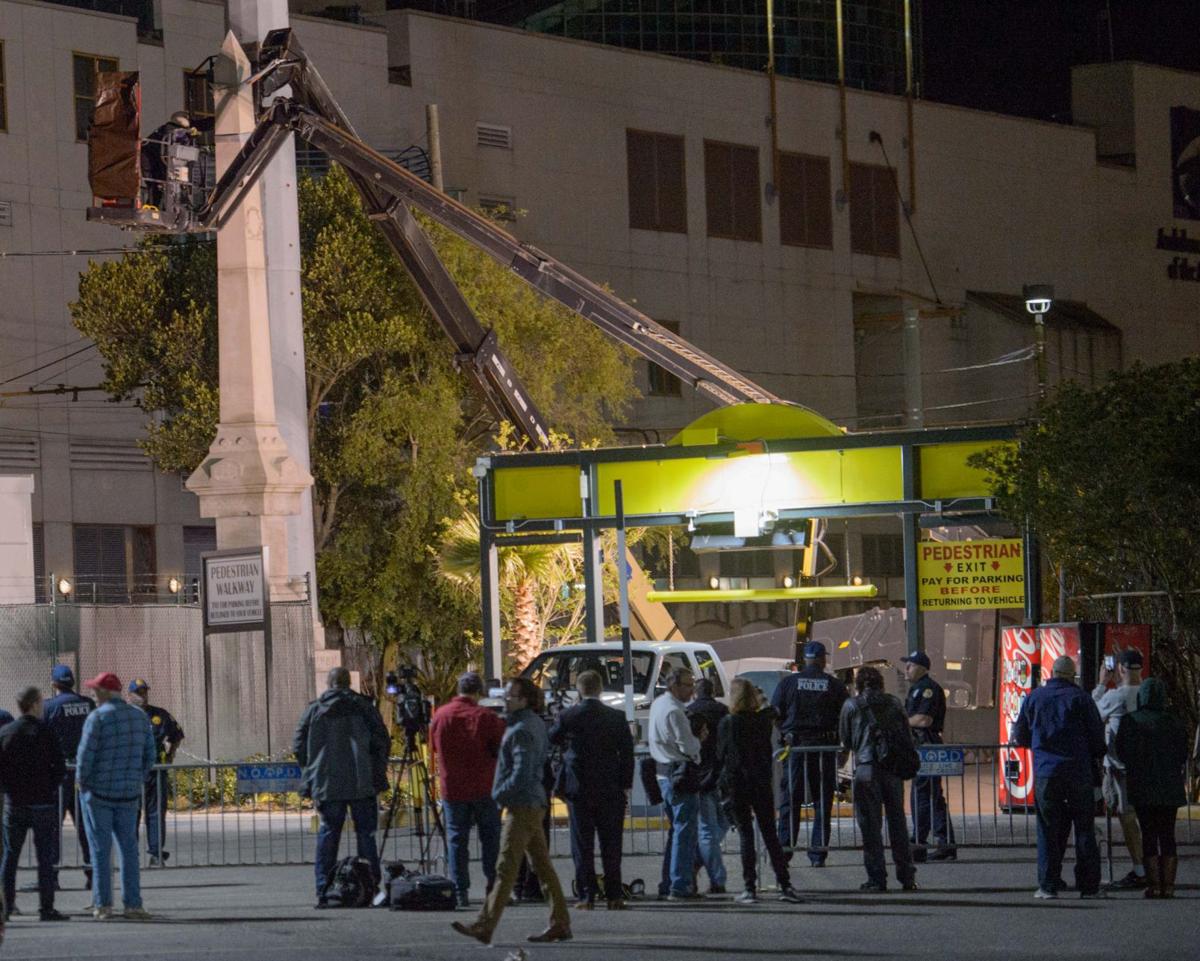

























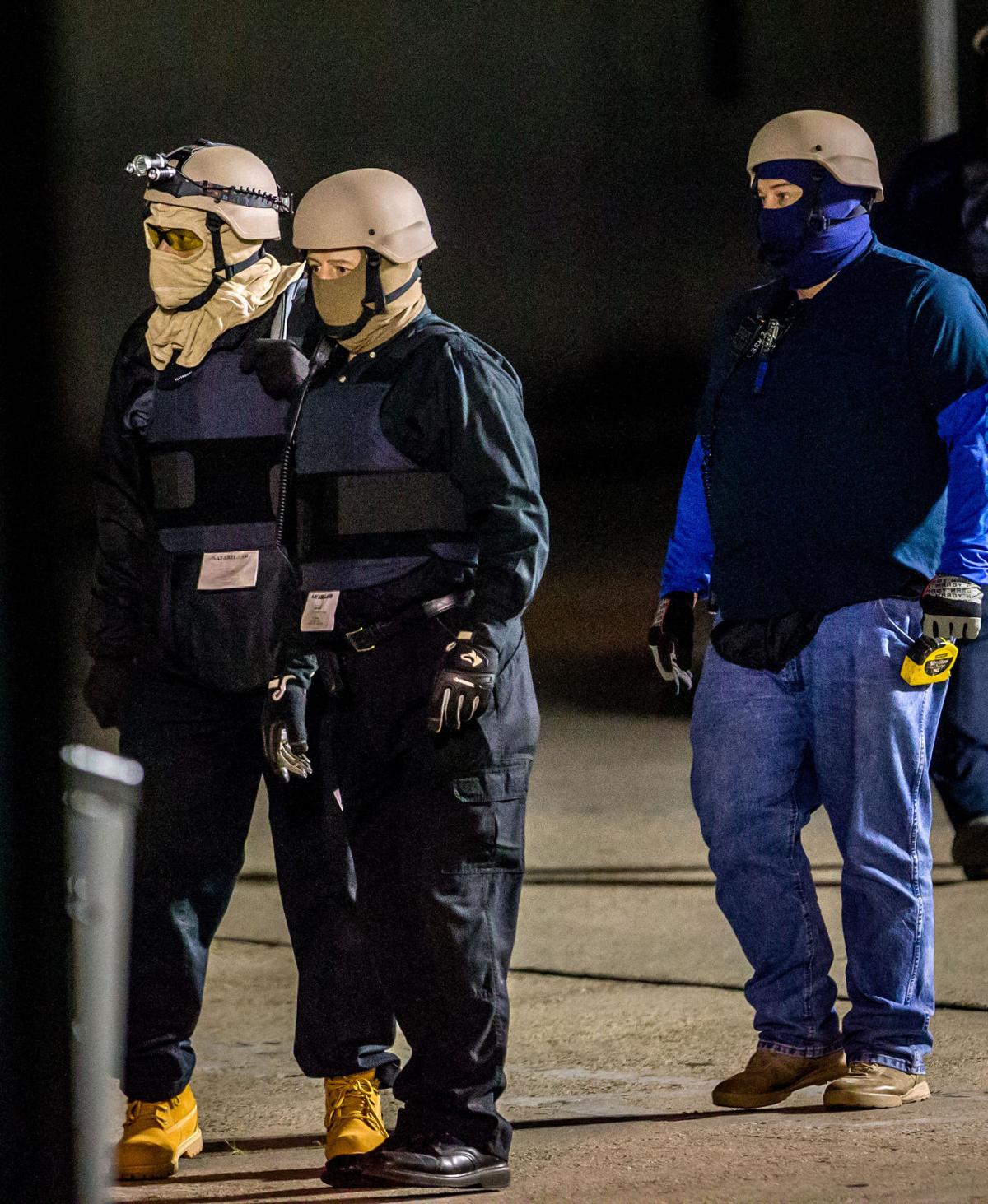

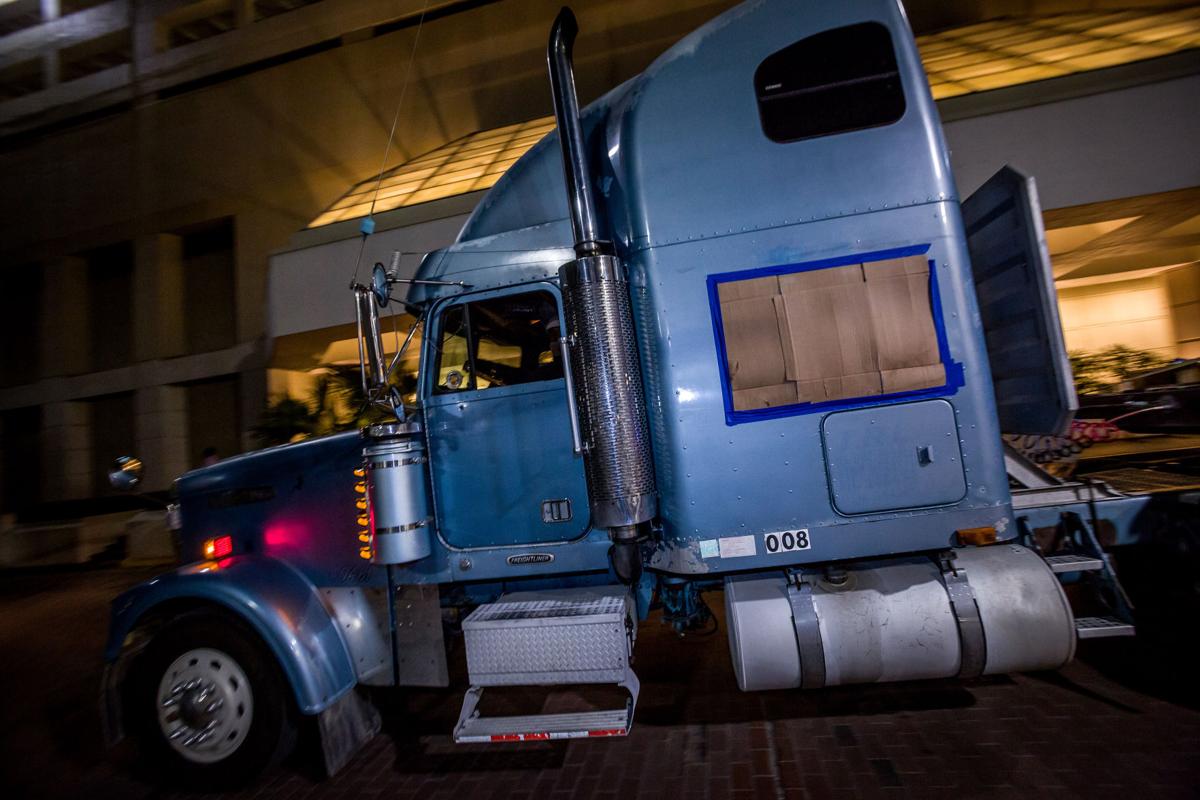
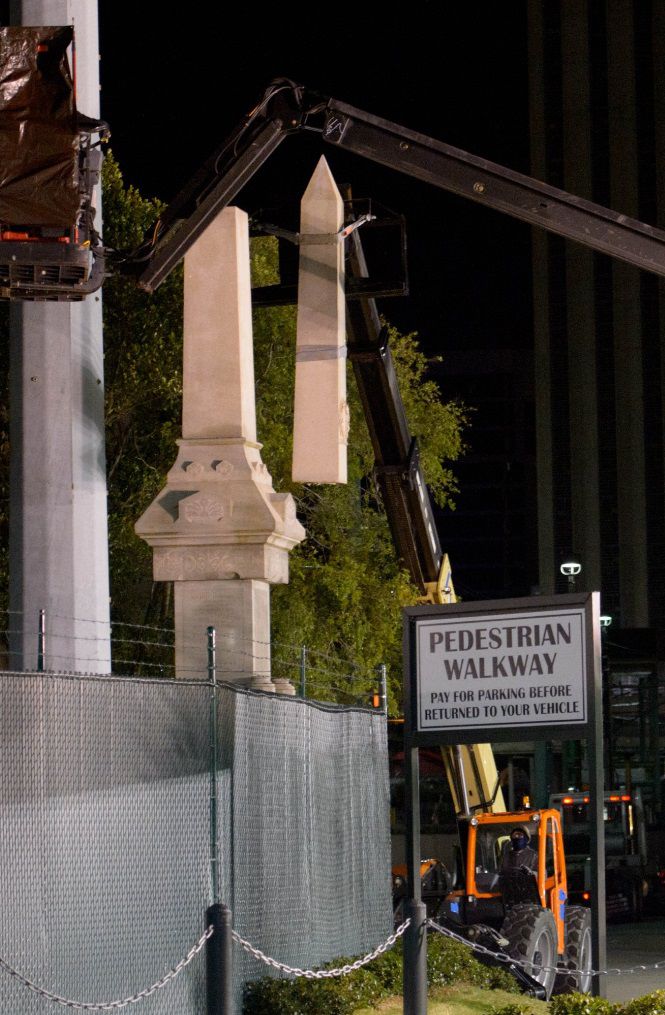
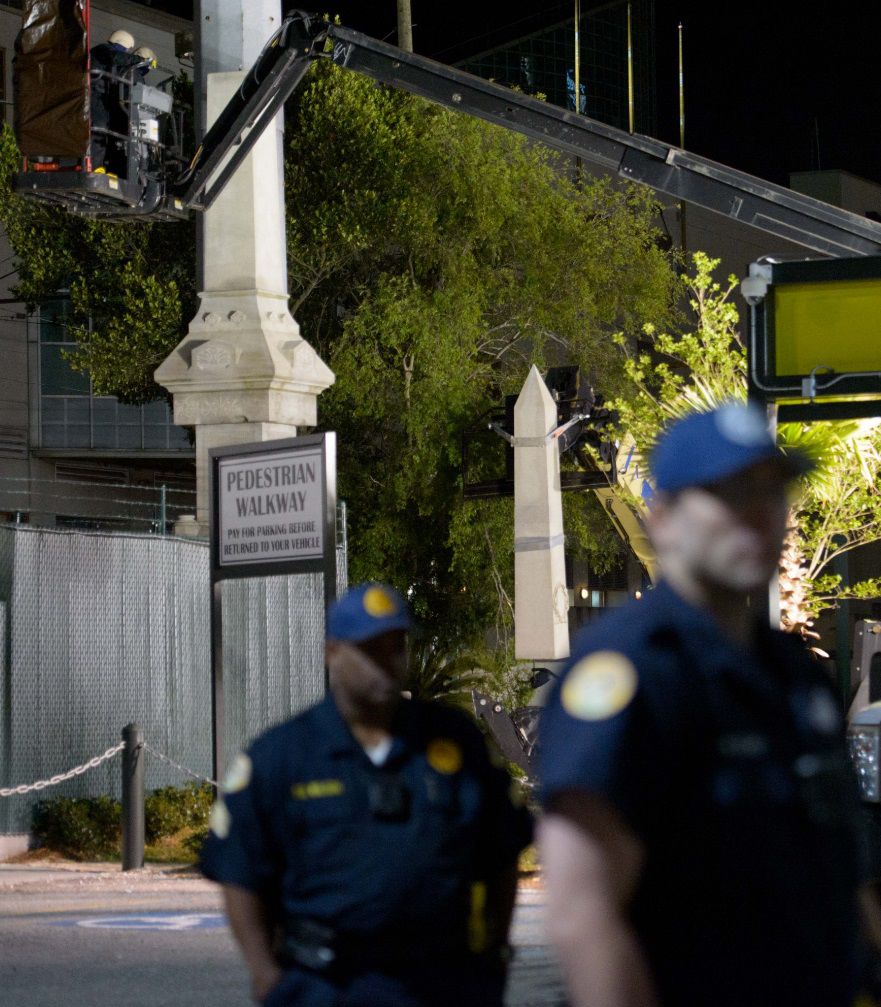


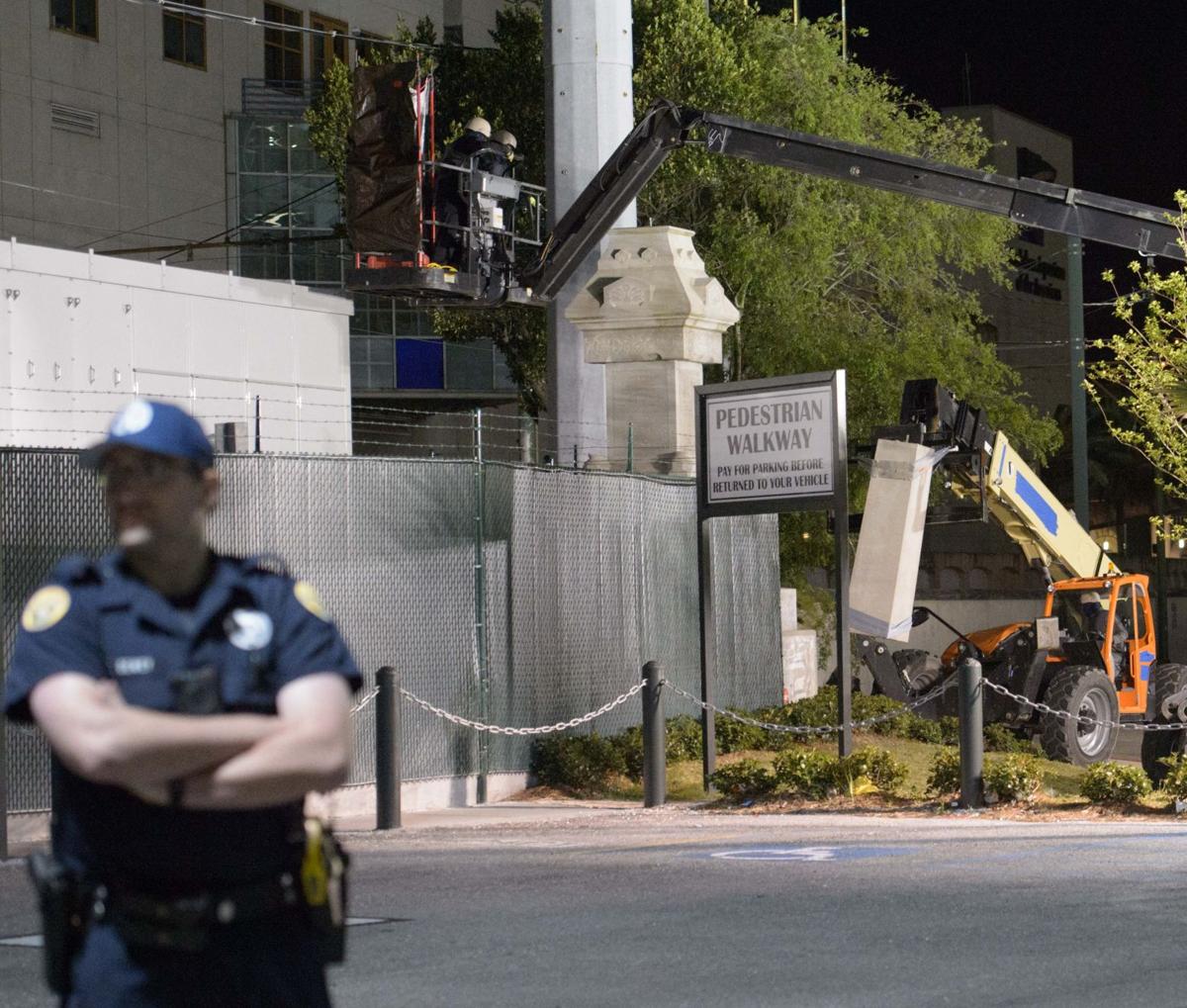

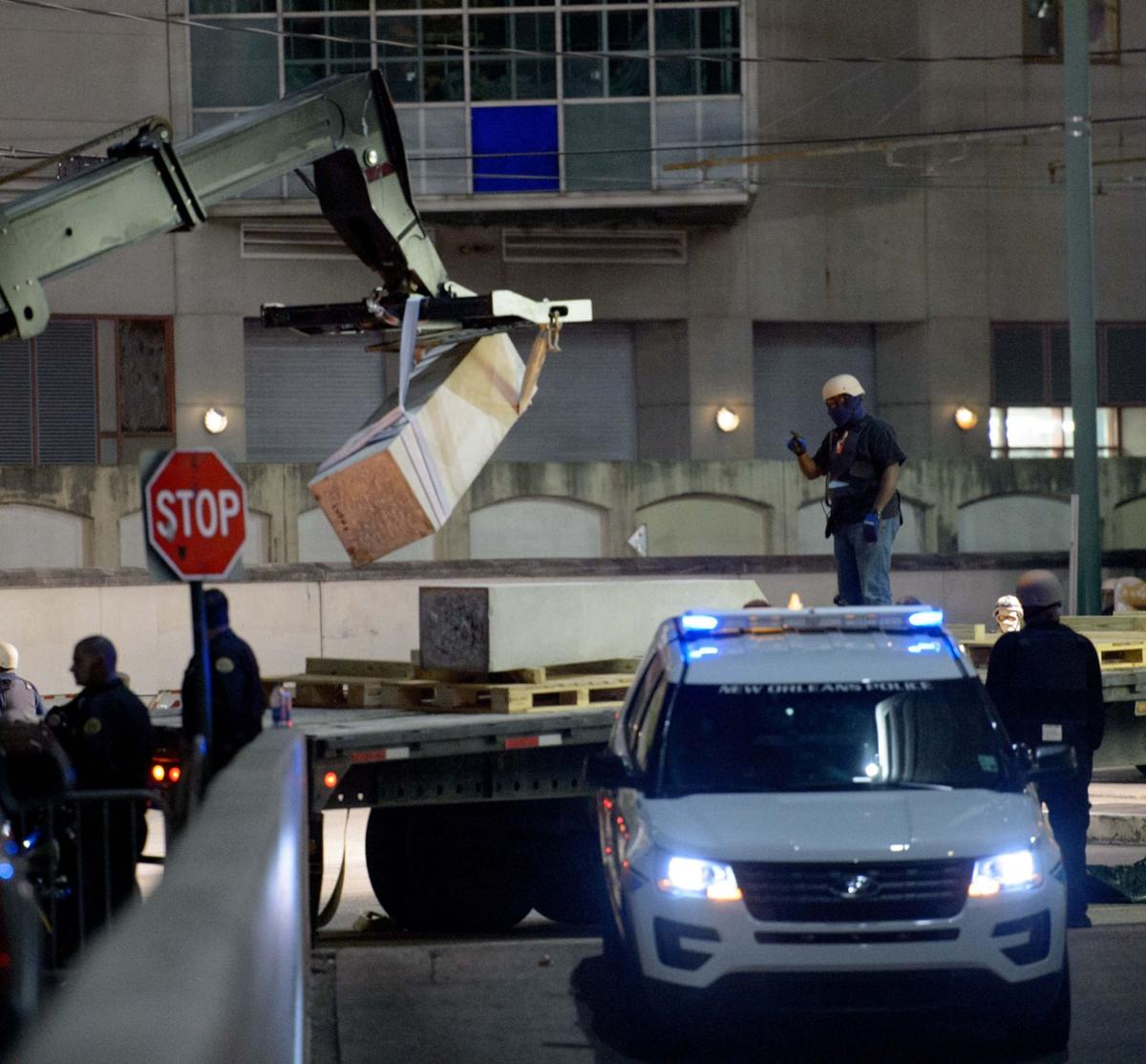
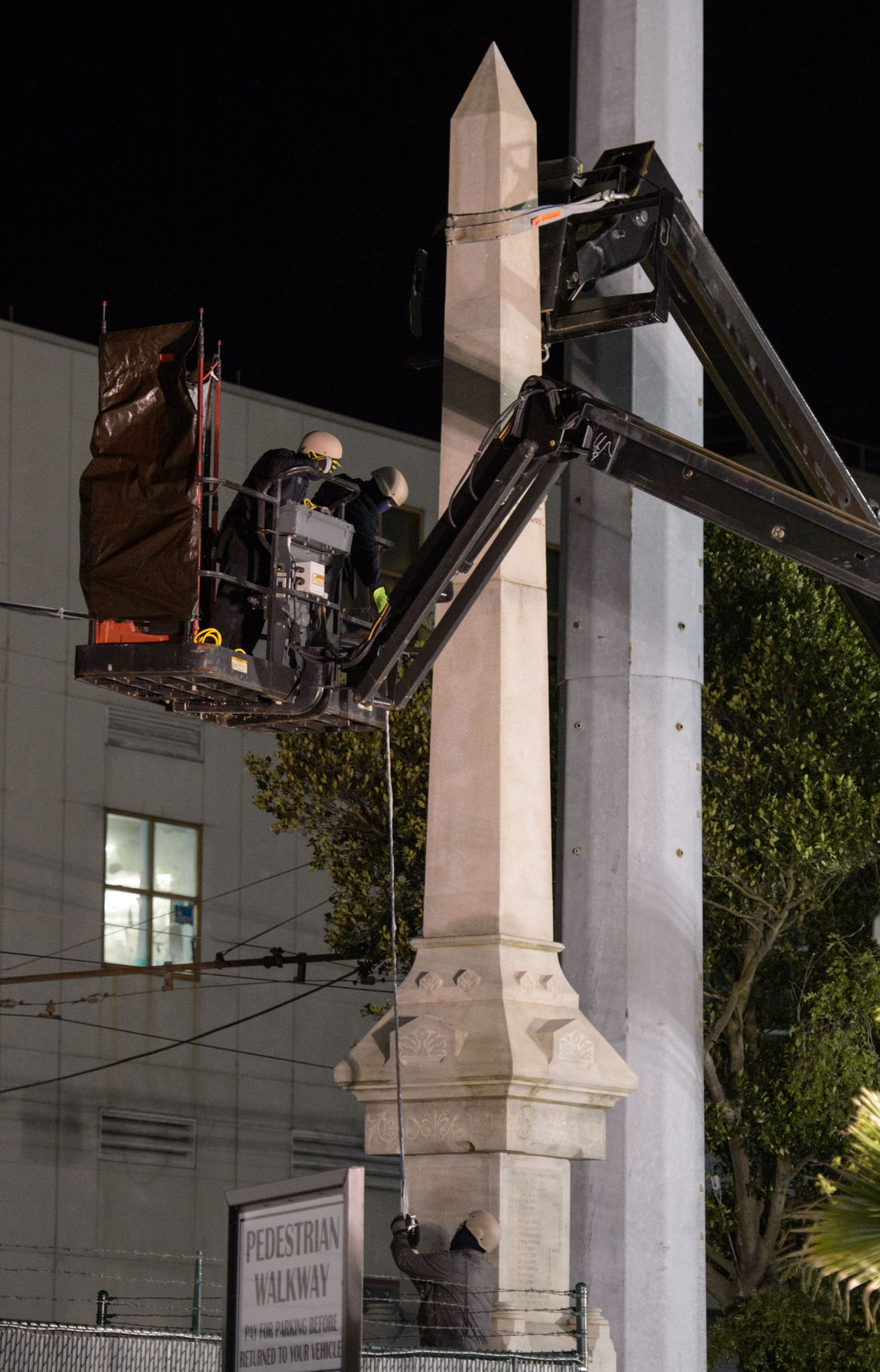
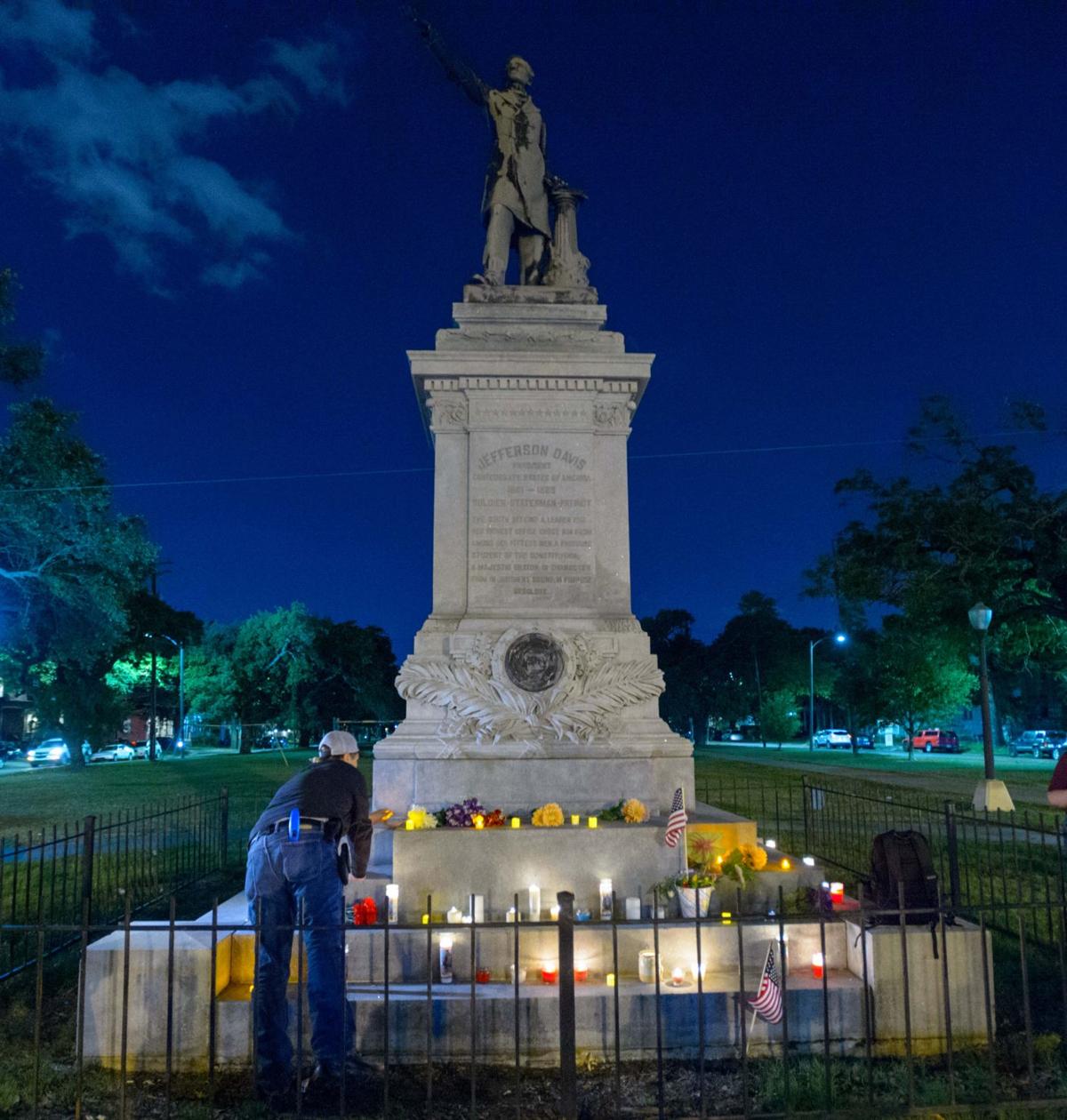
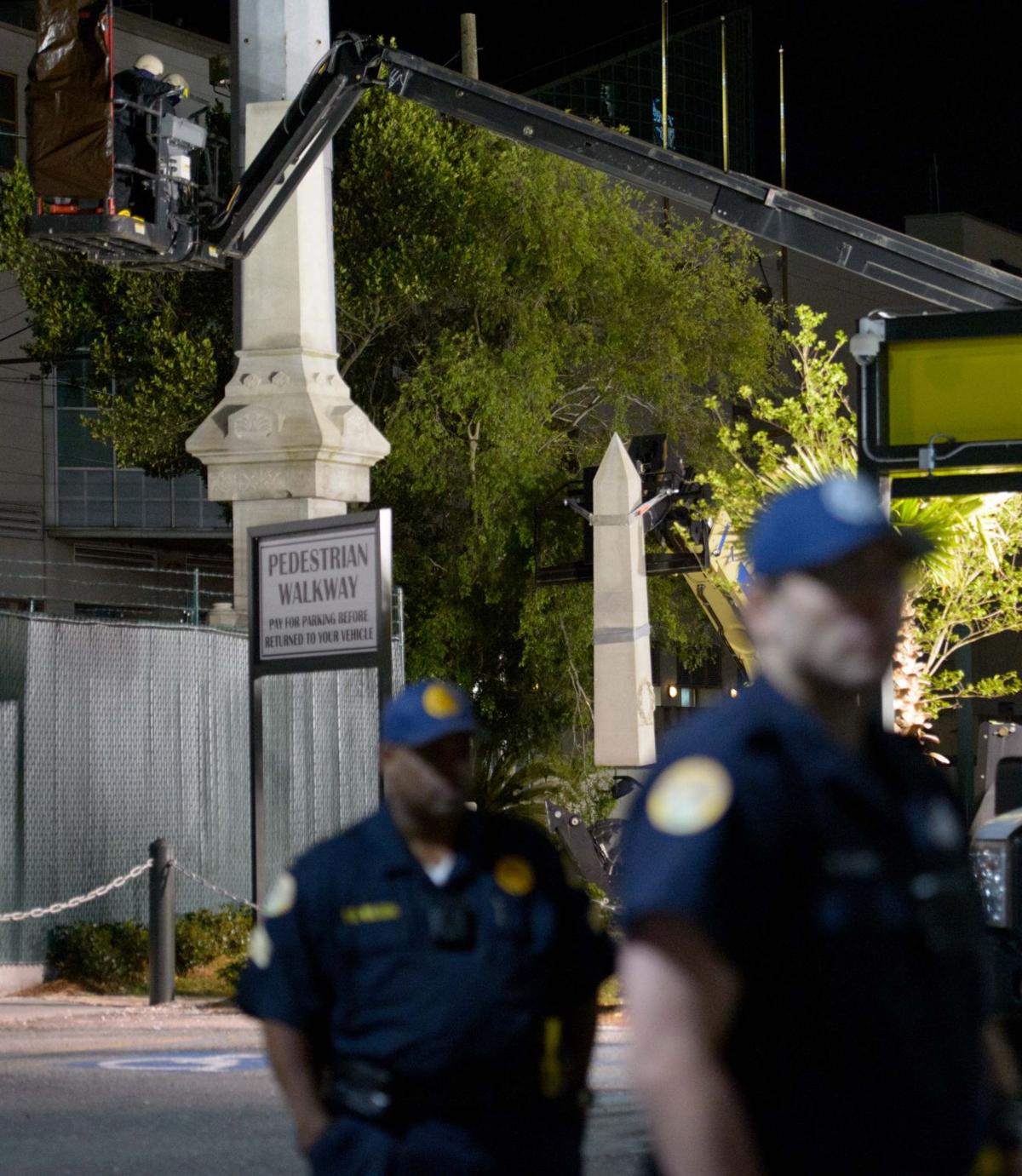

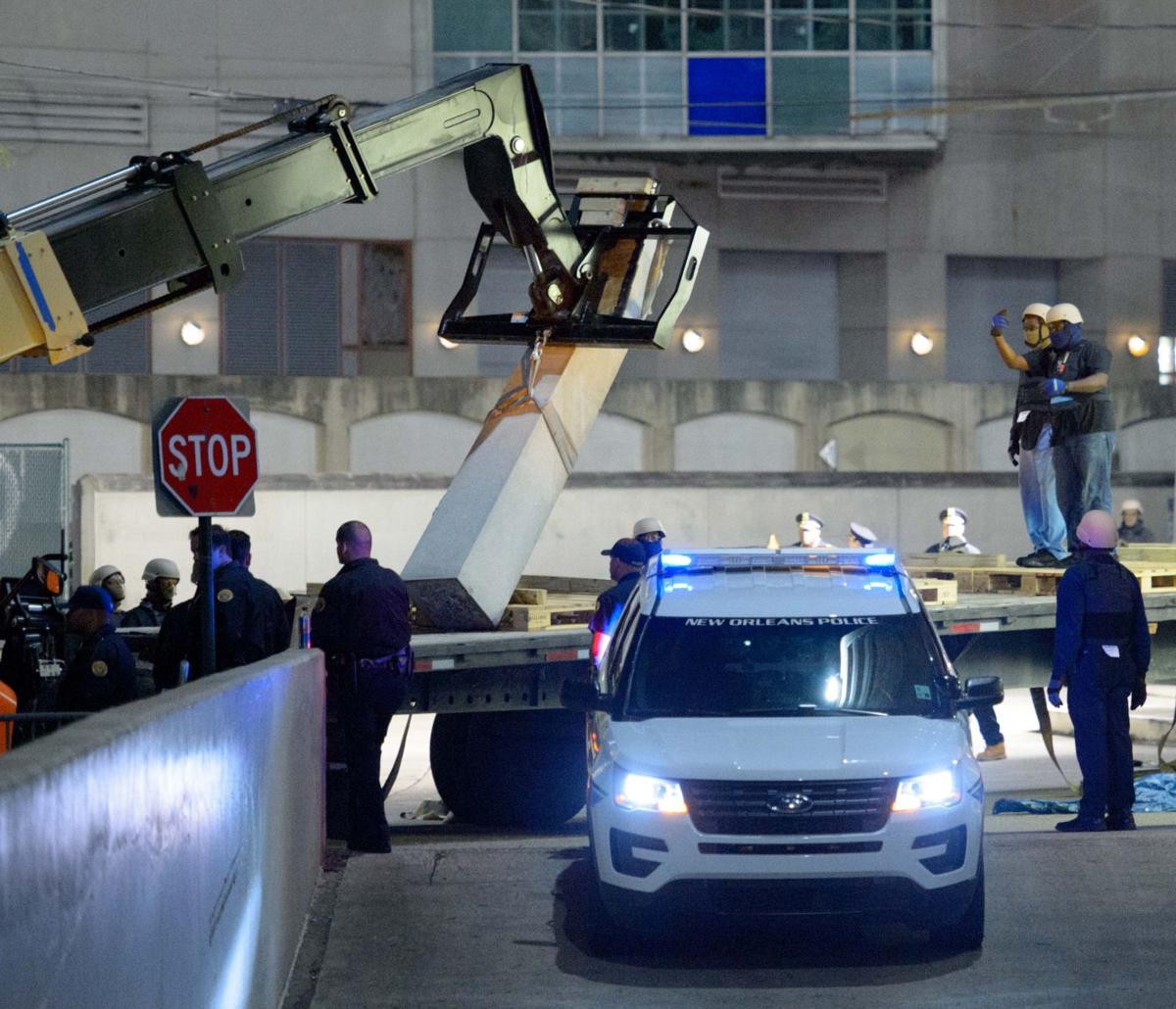

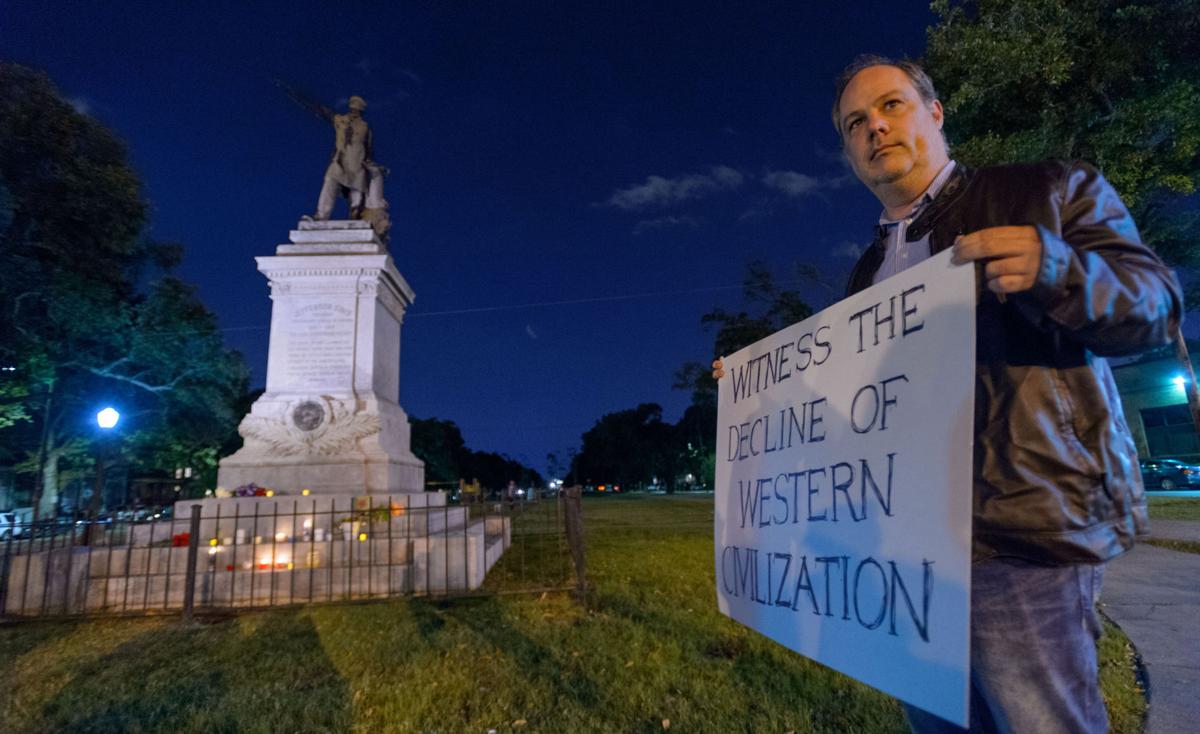








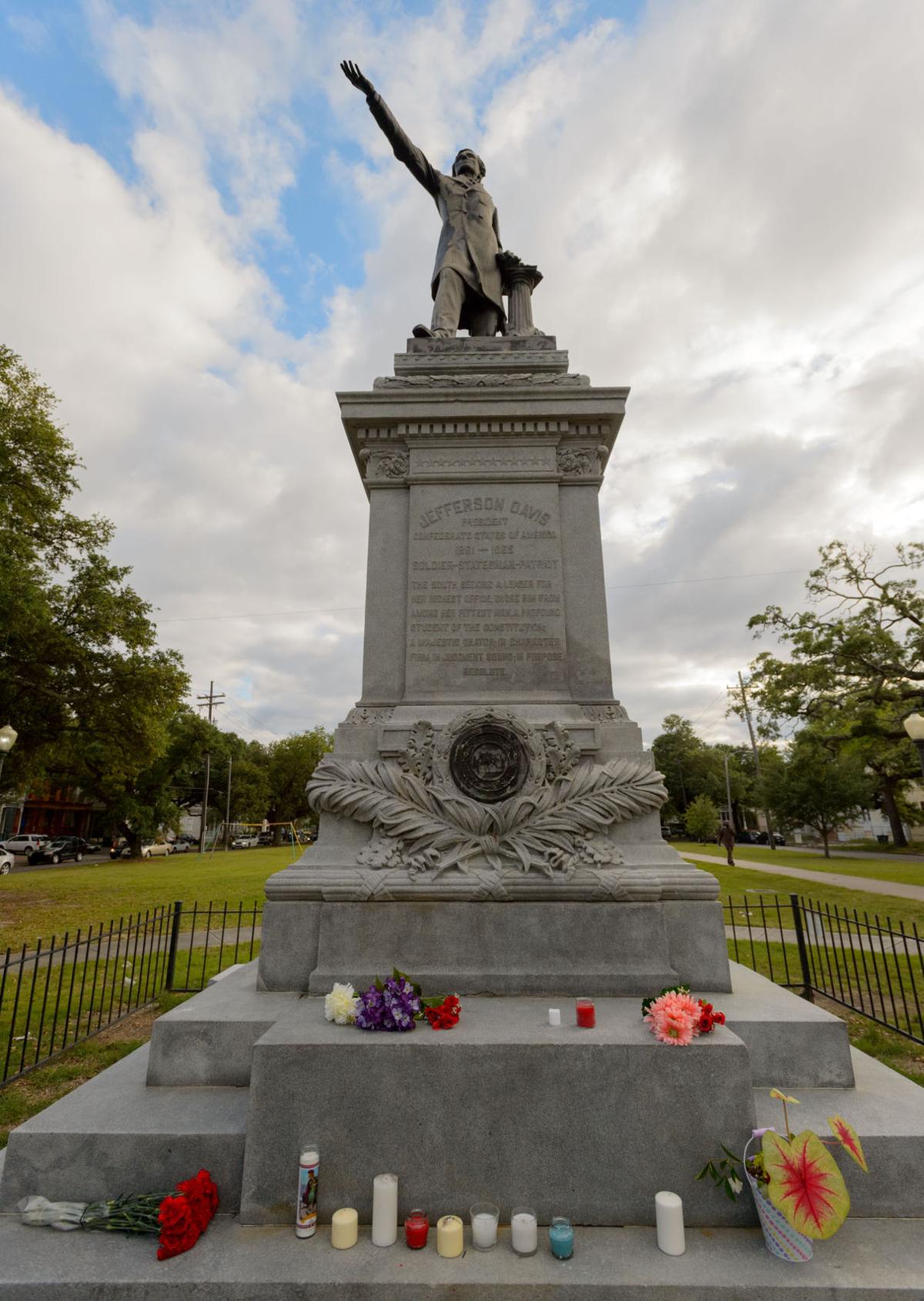
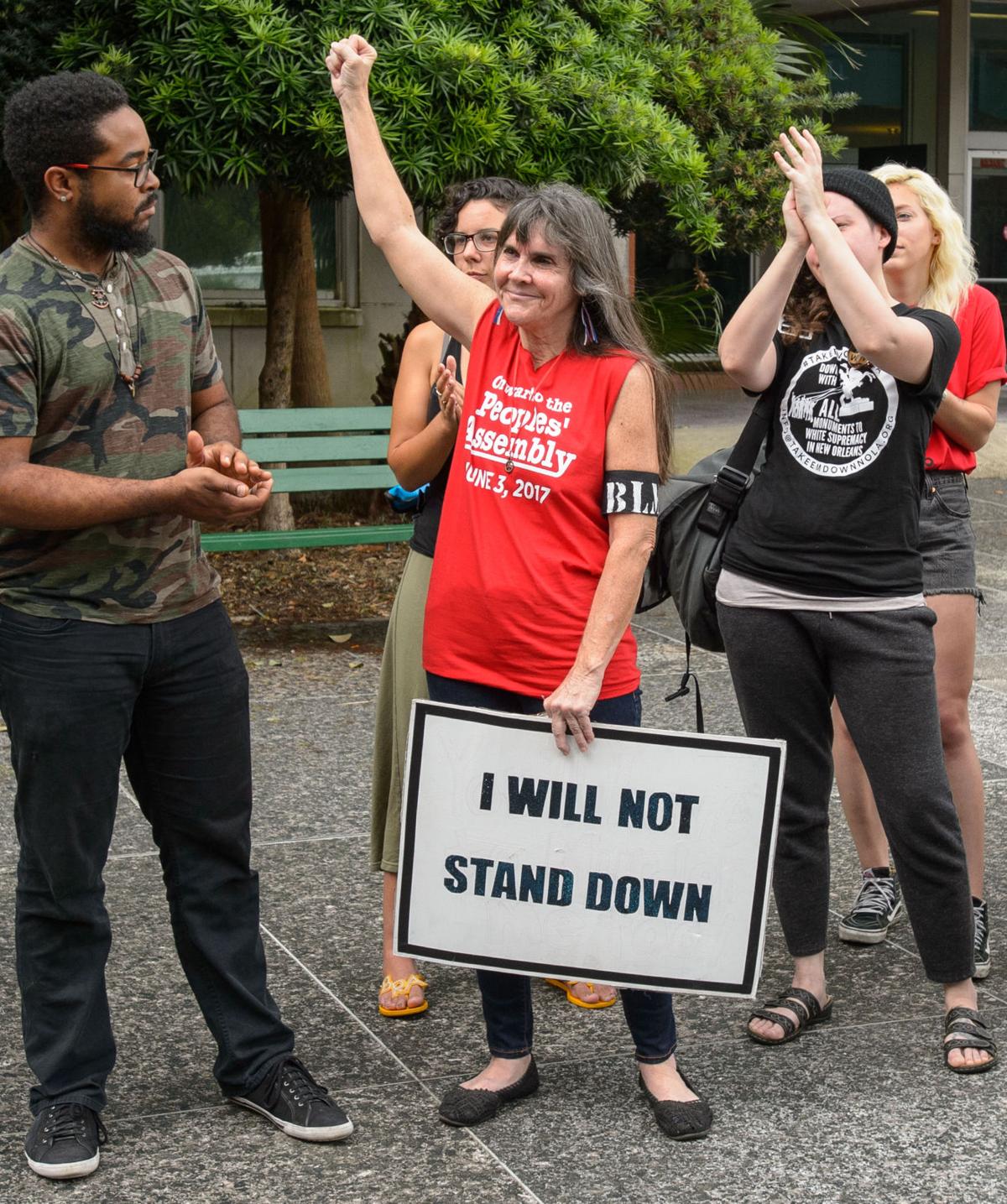
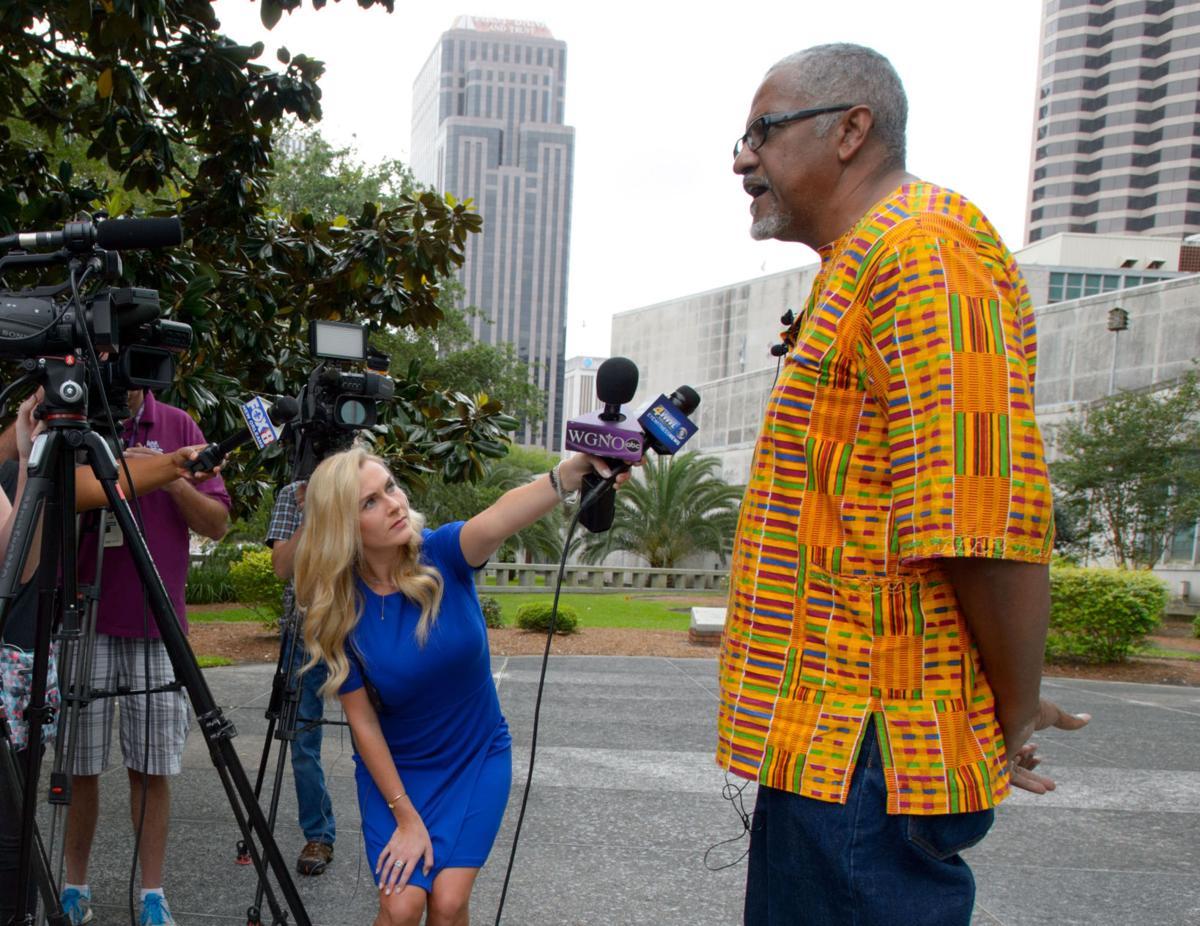
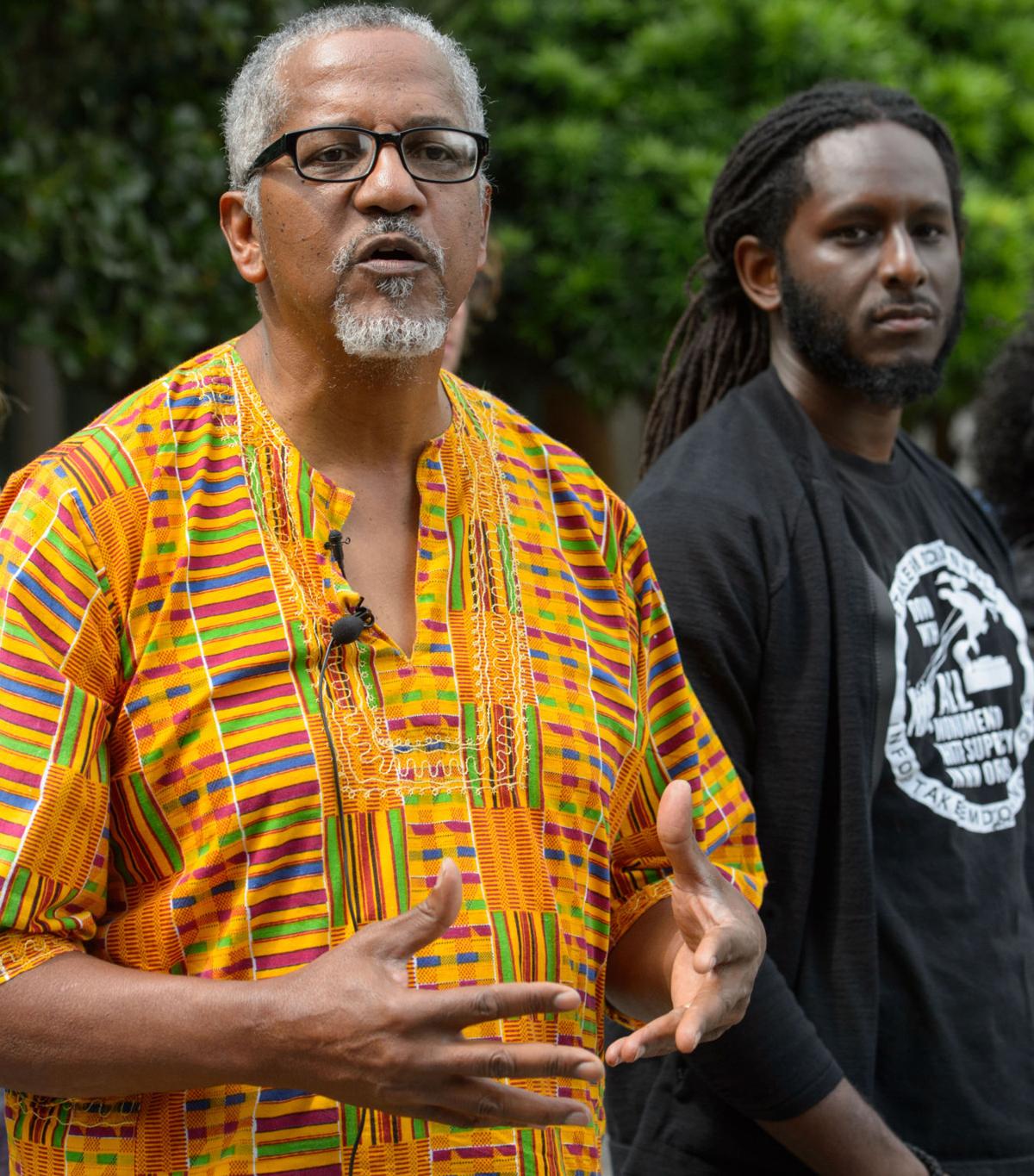
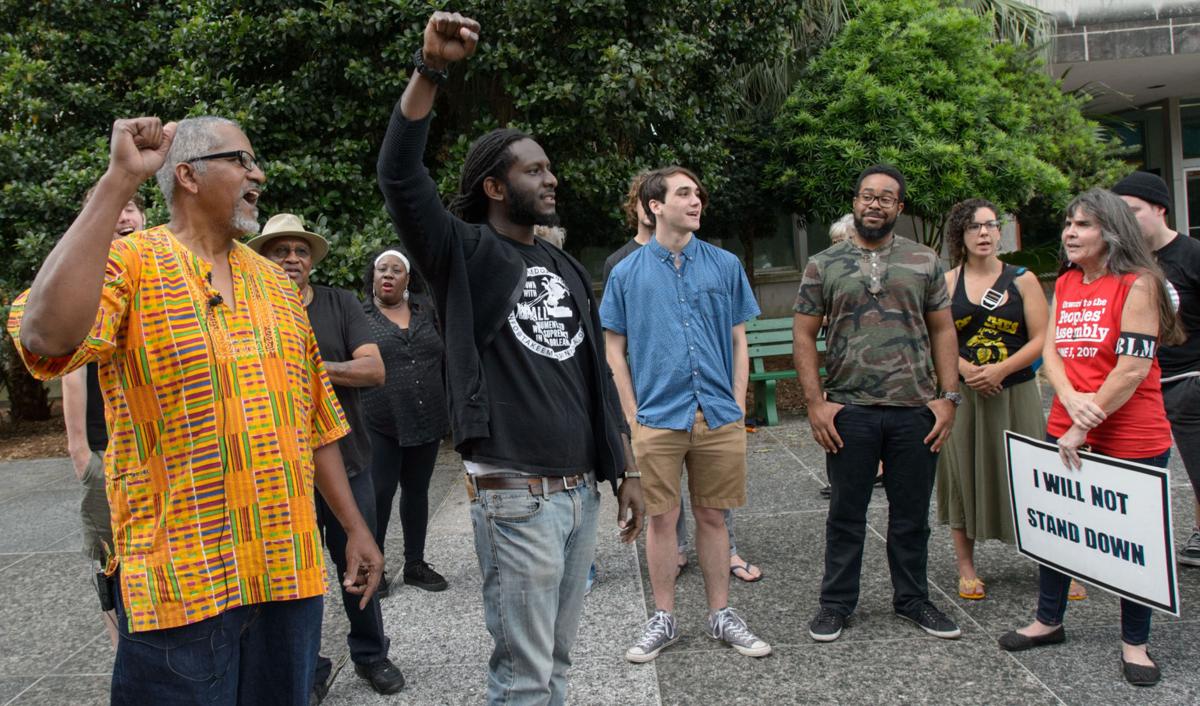
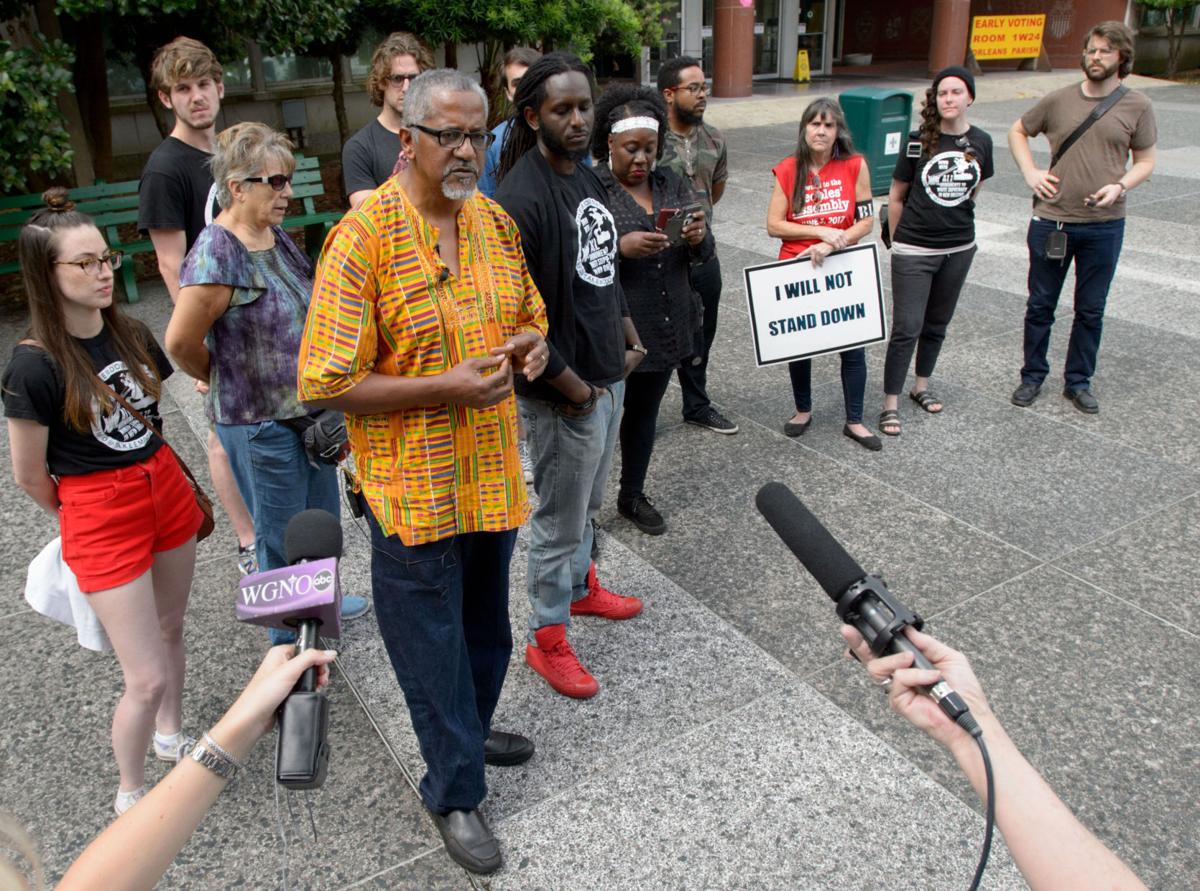

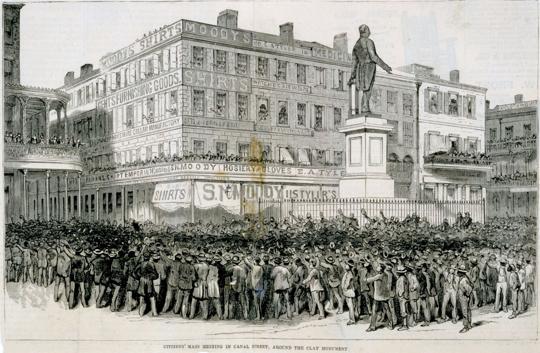
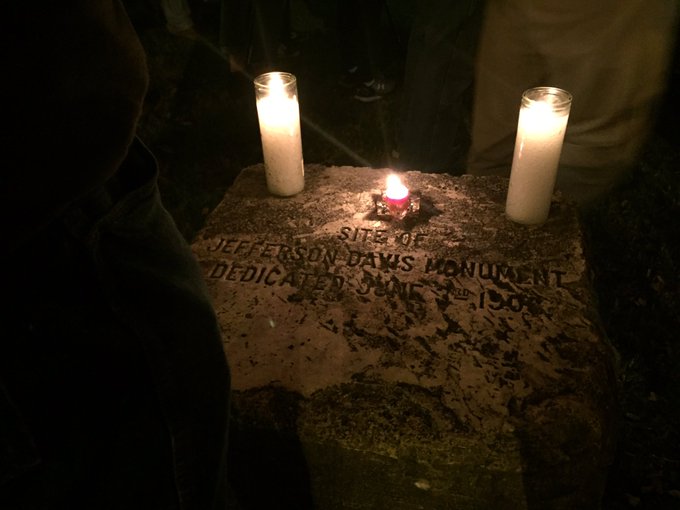
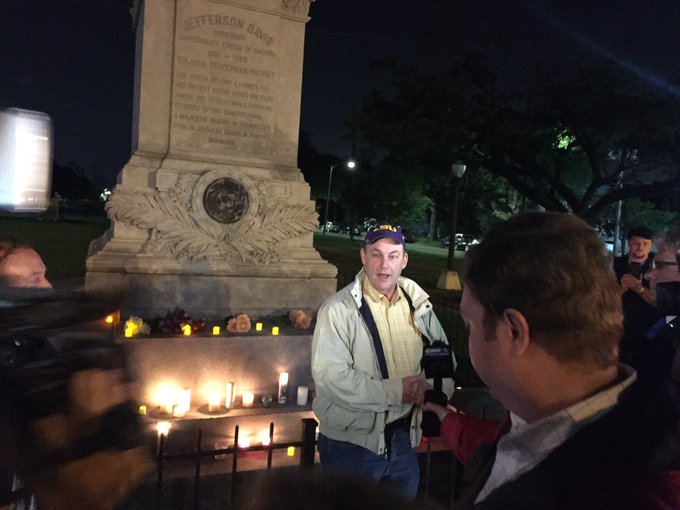

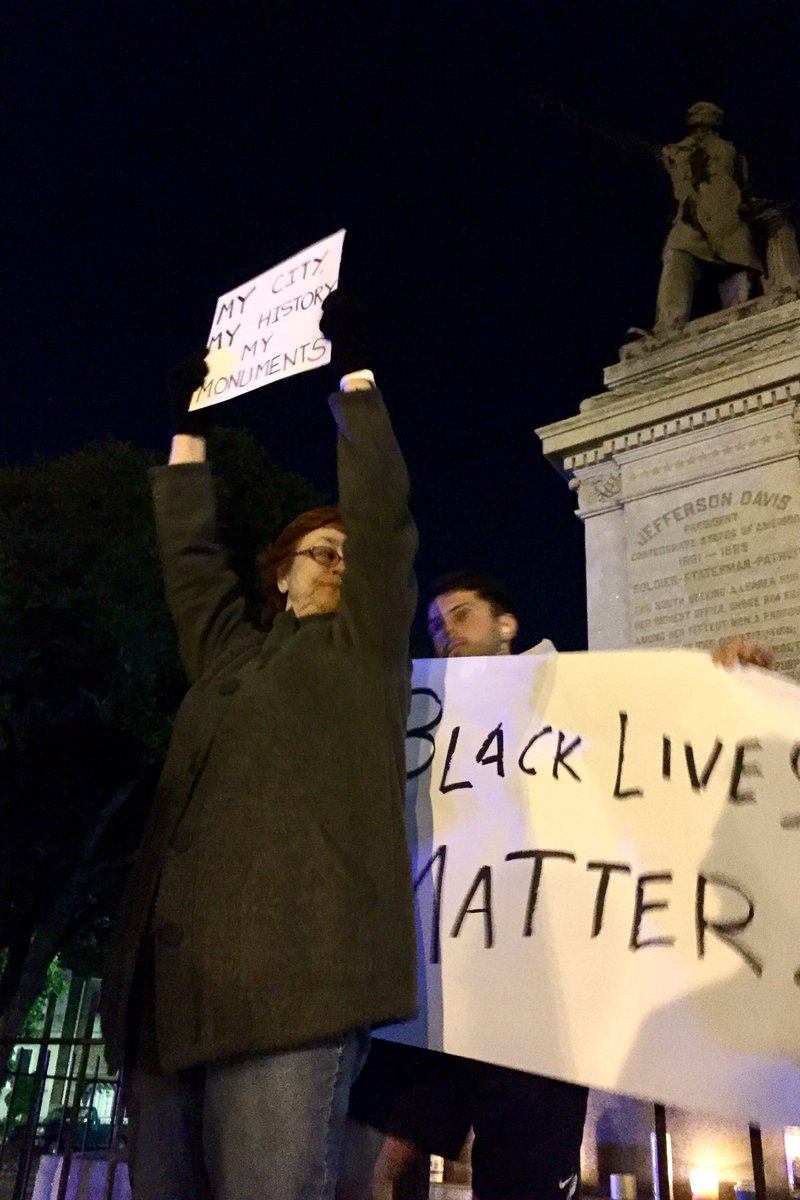

No comments:
Post a Comment
Thanks for commenting. Your comments are needed for helping to improve the discussion.